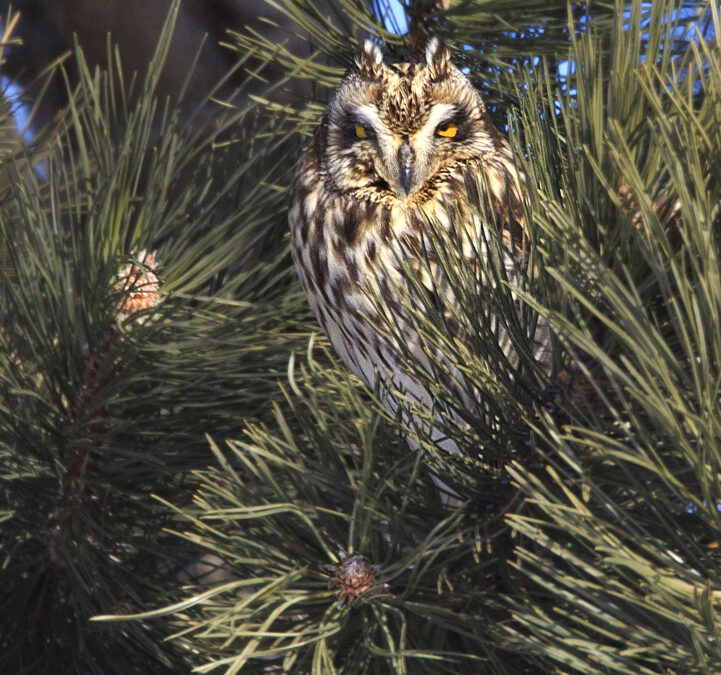
by Scott Martin Photography | Apr 15, 2014 | Birds, Blog, Educational, Raptors, Wildlife
Although I’ve been fortunate to see Short-eared Owls (SEOW) over the years, a good photograph of one has eluded me. It seems the longer you’ve waited, the more effort you will invest to finally get that desired shot, so perhaps not surprisingly I left home at 5:00 a.m. on a winter morning when the temperature was -25°C to embark on a 600 km round trip looking for Short-eared Owls. Fortunately, to make it an enjoyable day, I met up with my equally dedicated friend Arni and off we went. The plan was to be in the area where the owls had be seen for sunrise and although we did our part, there were no Short-eared Owls in sight. We looked faithfully for a couple of hours until Arni spotted one in a tree not too far off the road. We were relieved to find the owl however the nature of wildlife photography is that you often invest considerable time and expense to see a bird or animal and they simply don’t show up on cue. Seeing what you set out for is never a certainty and some times you must drive away empty, but when you are blessed to see what you set out to find you are elated and a good photograph becomes a bonus.
The Short-eared Owl Arni spotted was a fair distance off the road in the yard of a large farm, so we obtained permission from the owners of the farm to access their property to take some photographs. Here is the owl, nestled deep into the needles of an Eastern White Pine Tree.
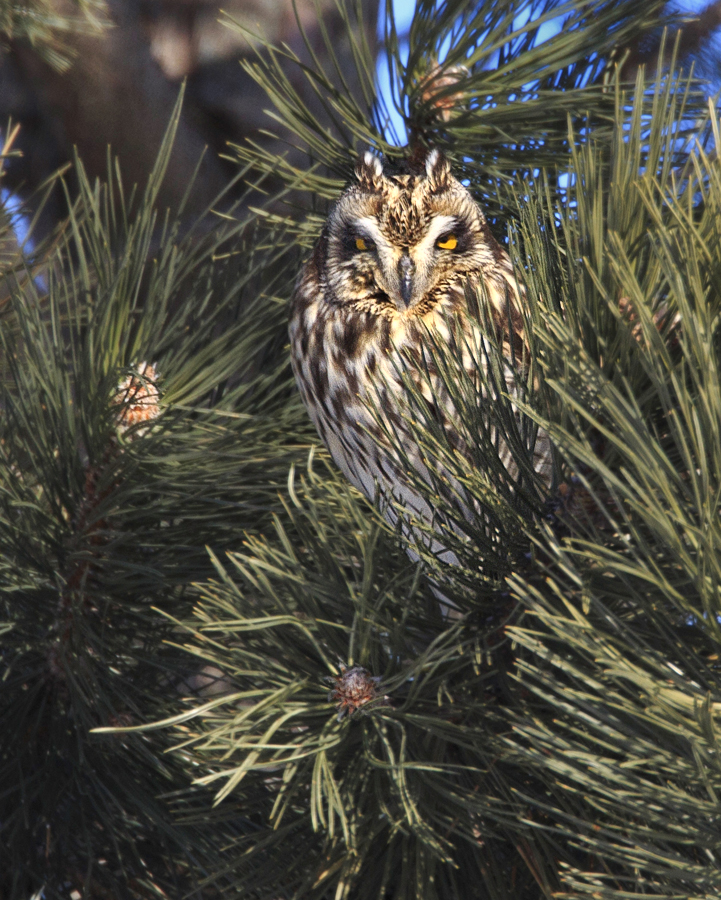
Unfortunately the owl flushed when we were about 100′ from the tree and we watched it fly down the road and perch in another tree. You can imagine our surprise when we packed up and drove down to the tree to find that it had joined six other Short-eared Owls! Seven owls in the same tree was quite an unusual sight. Here is a snapshot of two of them.
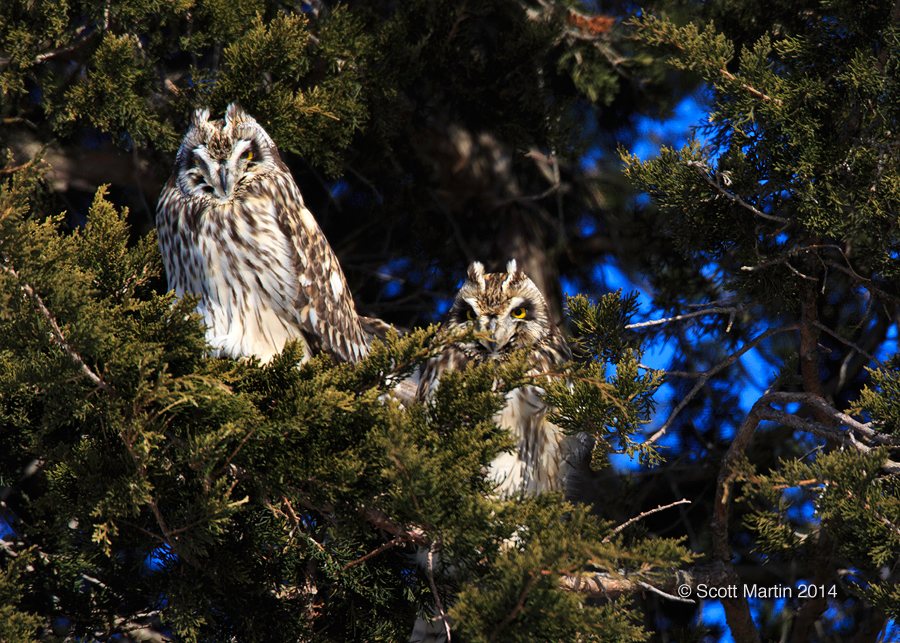
The Short-eared Owl shares a similar range and habitat as its cousin the Long-eared Owl and they even look somewhat similar with the exception of their short ear tufts and the horizontal black feathers around the orbit. Their small ear tufts are often not displayed however can be seen in the above two images. Short-eared Owls have always been one of my favourite looking owls primarily because of their eyes, which have been referred to as mascara eyes because of the unique black feathering around the eyes. The next few images will demonstrate those alluring mascara eyes.
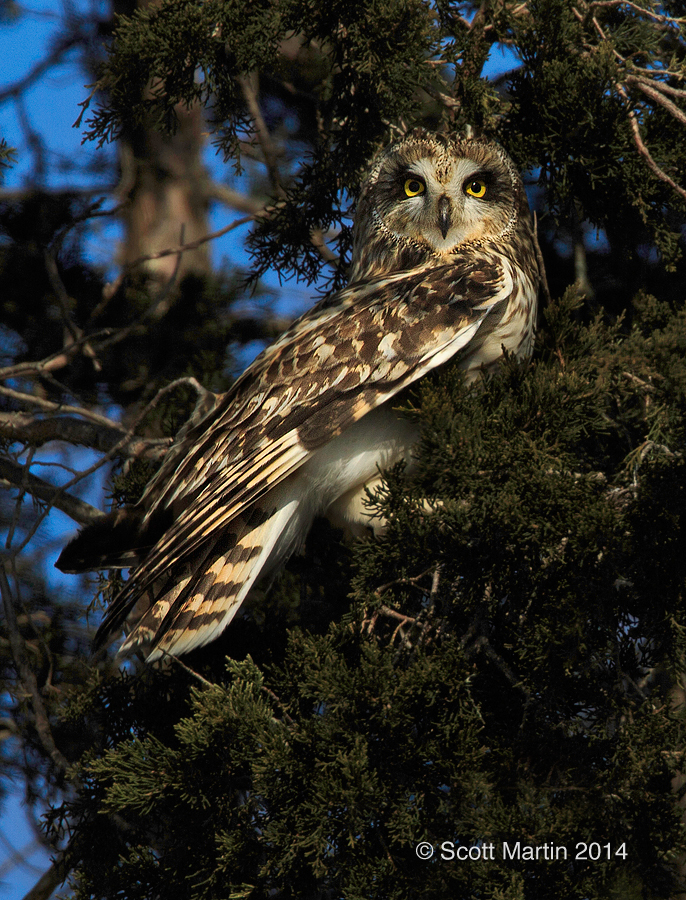
The Short-eared Owl is a globally common owl and enjoys one of the largest geographic distributions amongst the owls, being found on all continents with the exception of Australia and Antarctica. It is however in Ontario listed as a species at risk and of special concern.
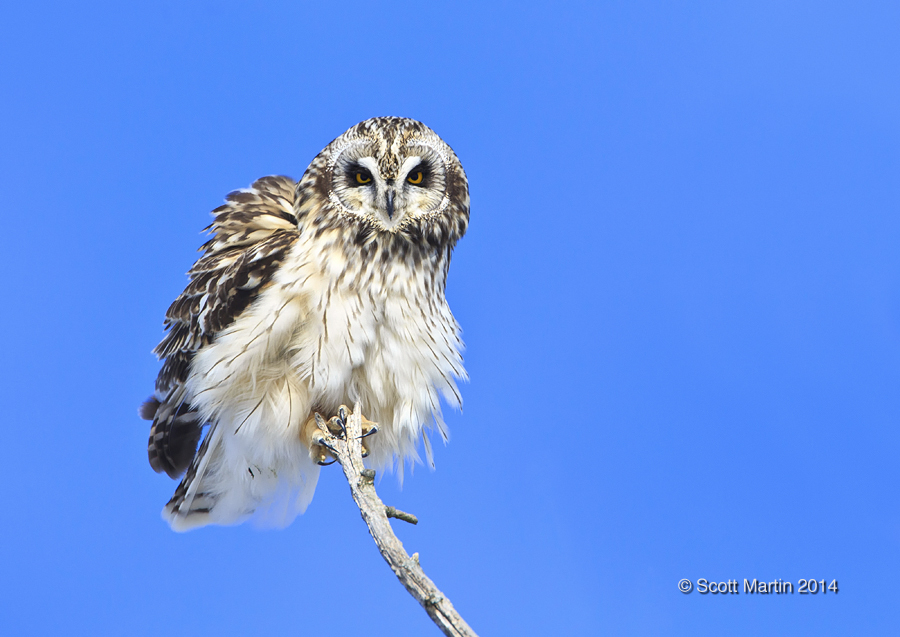
.
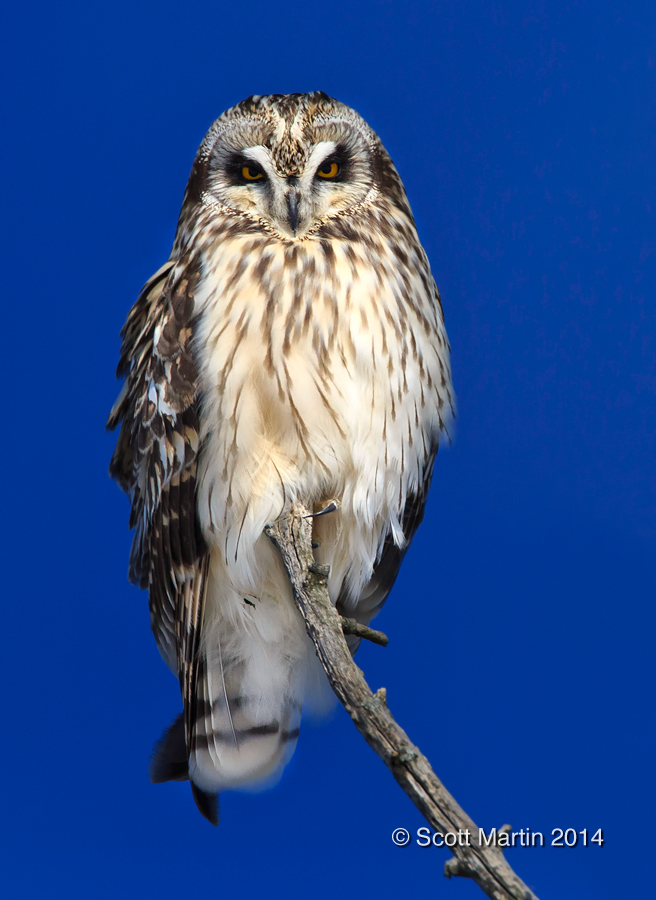
Capturing in flight images of the Short-eared Owls was a treat as they are largely nocturnal birds that roost through the day.
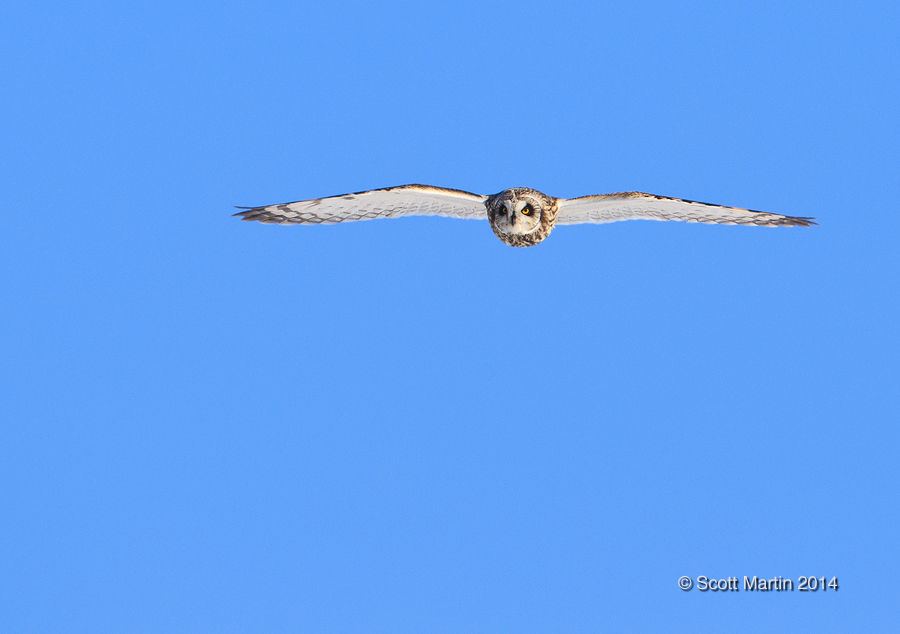
.
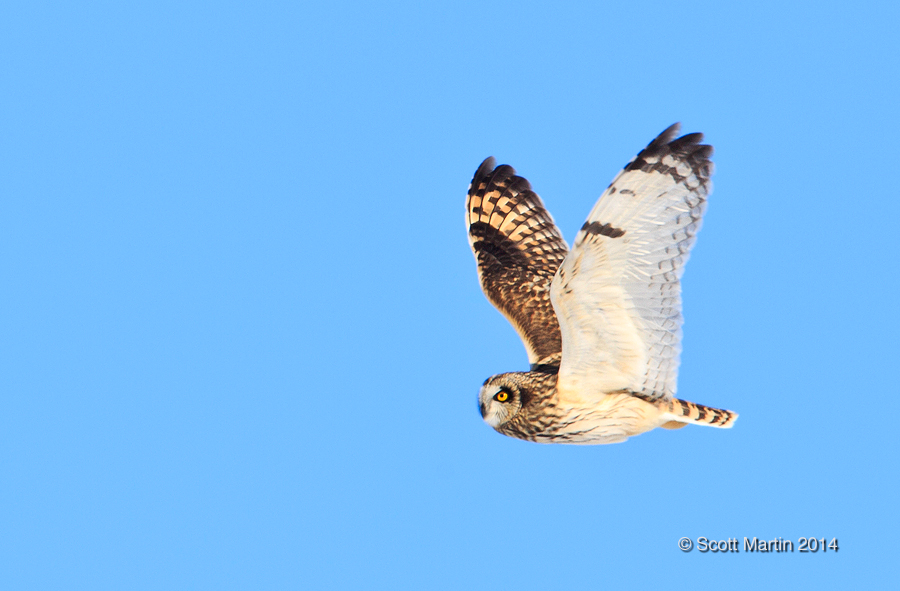
After photographing these beautiful birds we headed about 15km further south west to the shores of Lake Erie not too far from the little hamlet of Selkirk in search of some other unusual birds that had been reported in the area, however as it often happens , none of the expected birds made an appearance so we made our way home stopping at Lynde Shores Conservation Area in Whitby to see a resident Red-bellied Woodpecker (RBWO). Although it was very cold, the light was nice and the birds cooperative, so we were able to get a few images.
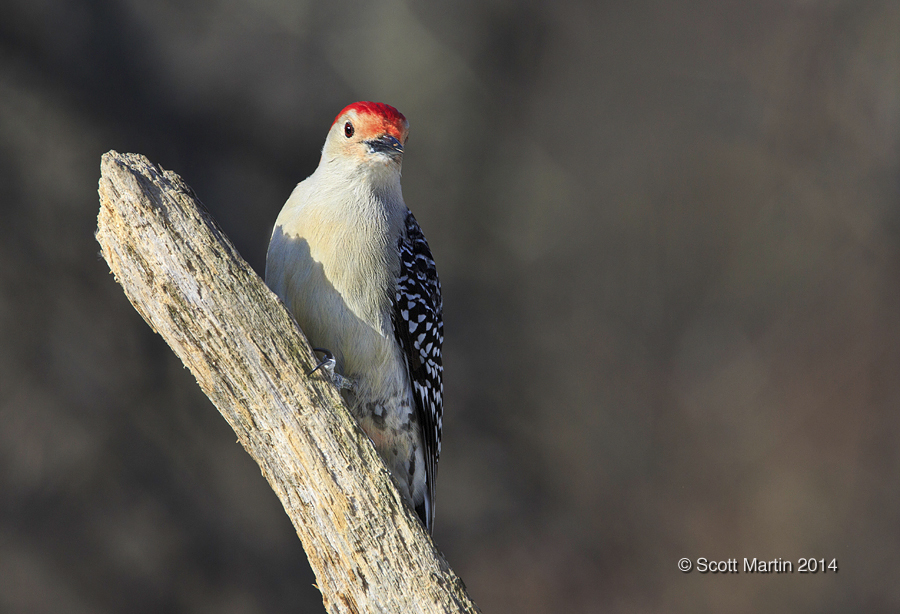
.
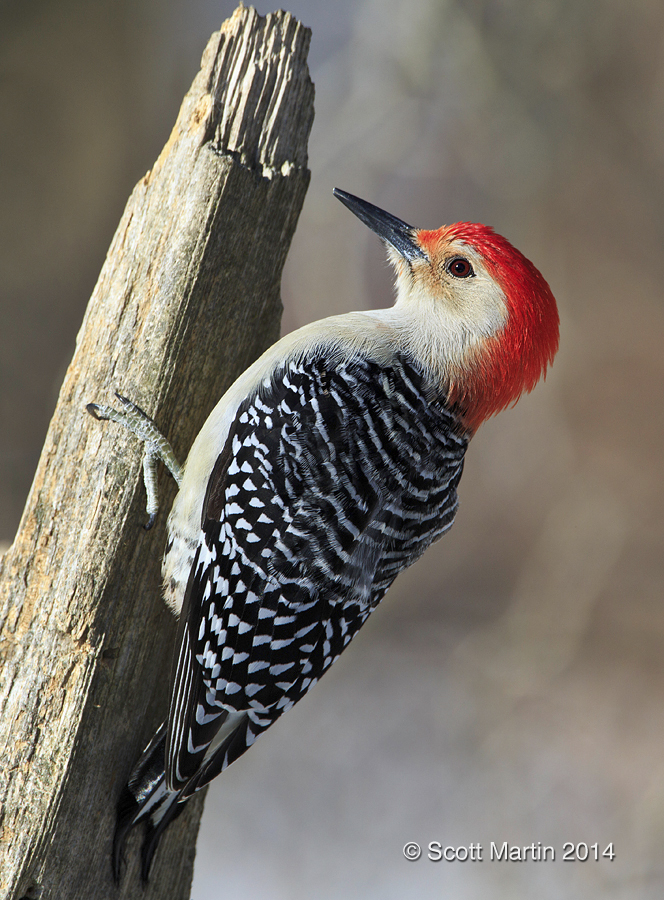
It’s always good to have some black sunflower seeds in your pocket as the seemingly ever present Chickadees (BCCH) are usually in need of a snack.
The week after the images in this post were taken Deb & I headed to Florida for a couple of weeks and were fortunate enough to spend a few of those days birding and collecting enough images to put together one or two future blog posts. So the next post will feature some birds of the south where the warmer temperatures were a most welcome respite.
All of the Short-eard Owl and Red-bellied Woodpecker in today’s post were taken with a Canon 5D MkIII and Canon EF 500 L IS lens with a 1.4X TC for a focal length of 700mm. The Chickadee video was via my iPhone 🙂
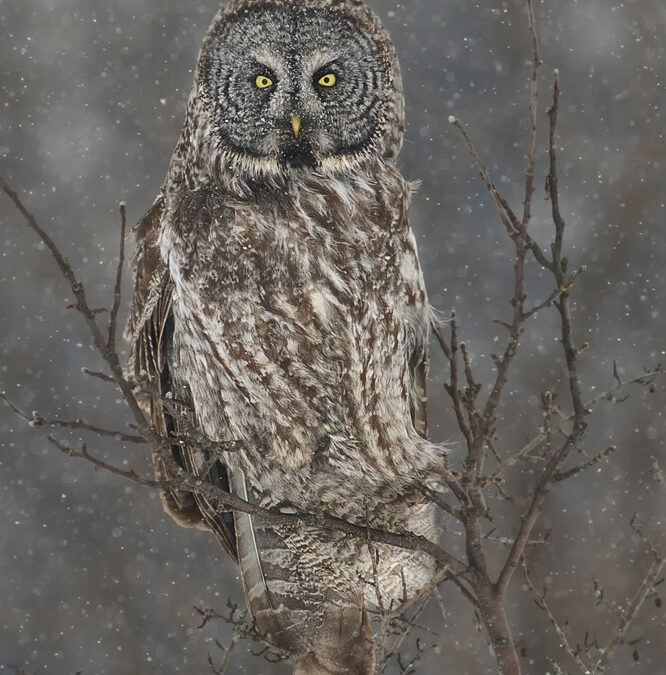
by Scott Martin Photography | Mar 22, 2014 | Birds, Blog, Educational, Raptors, Wildlife
Before people start questioning the title of today’s blog, please let me clarify that the Great Gray Owl is the world’s longest owl with a recorded body length of up to 33″ (and a wing span of over 60″). You may want to think of this a deceptive length as it is the large head and fluffy feathers (better insulation) that are hiding a proportionally smaller body, such that many other owl species are heavier than the Great Gray. Anyway, the take away is that the Great Gray Owl is a very large and majestic looking bird, which I believe is captured in this first image which is also my favourite owl image from this past winter.
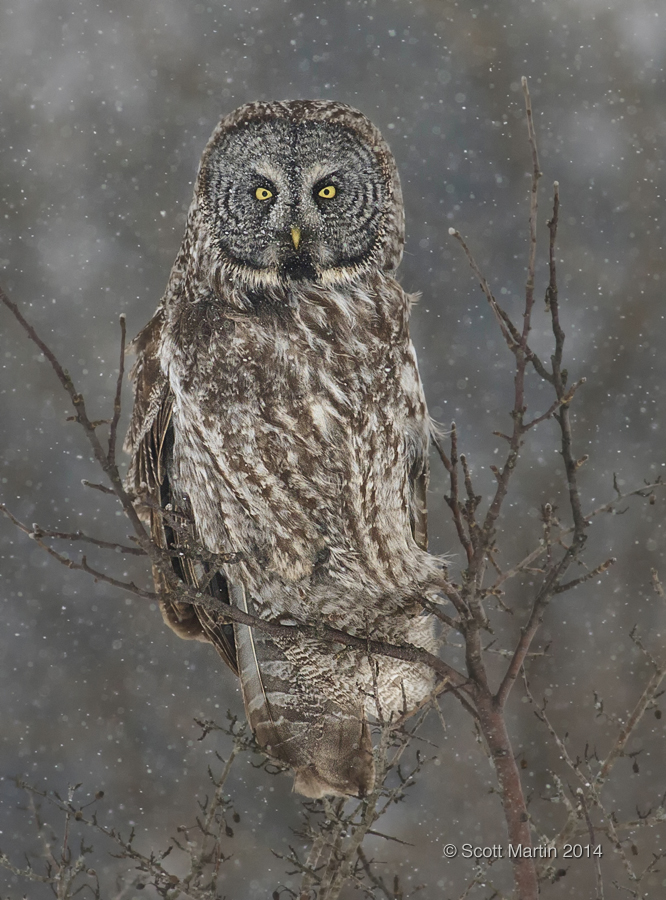
The Great Gray Owl is a northern owl that breeds in the far north regions of North America, Europe and Asia and although a nomadic bird, they do not migrate. As non-migratory birds, they are sometimes seen farther south than normal in years when food sources in the north are scarce and competition for food forces some birds to head south until they find more abundant food that they can successfully compete for. Their diet is 80% small rodents (voles and mice) and 20% from alternate prey sources including small birds and ducks.
This winter we were fortunate have a Great Gray Owl take up residence just north of Brooklin Ontario, not more than a ten minute drive from our house, which provided plenty of opportunities to photograph this celebrity visitor. And a celebrity it was, attracting birders and photographers from many miles away on a daily basis.
You probably noticed the image above was shot while it was snowing, which certainly adds to the photograph and serves as a reminder get out there when it’s snowing (or raining) as some of the best images are obtained in inclement weather. When it’s snowing you do need to take some time to think about how the snow will affect the image and how you wish the snow to appear in the image, just as you would for any of the elements that occupy the frame. Personally, I prefer the snow to be either frozen in the frame (pun intended :)) and appearing as round flakes, or heavily blurred to illustrate the wind and provide that winter storm look. An exposure time that allows just a little bit of movement in the flakes creates an unappealing optic with the snow appearing as a distractive cloud of gnats. The first image above was taken at 1/2000 sec, which preserved the round snow flakes. This next image was taken at 1/500 sec, allowing some motion in the snow flakes and creating that unpleasant fly look which you want to avoid.
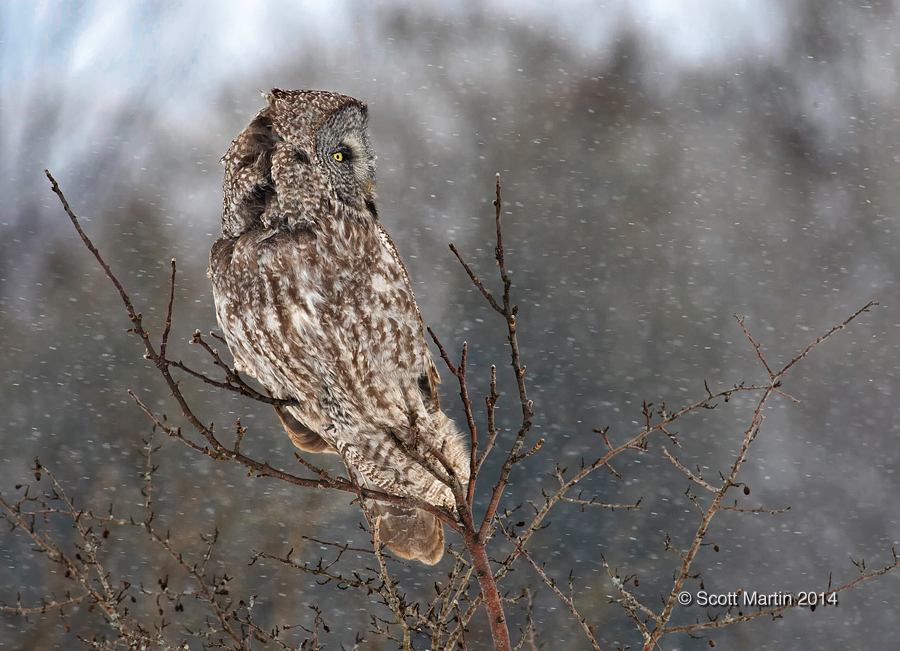
A much slower exposure of 1/30 sec was used for the next image which fully blurs the snow, but in a way that contributes to the success of the image by giving the feeling of the wind driving the snow.
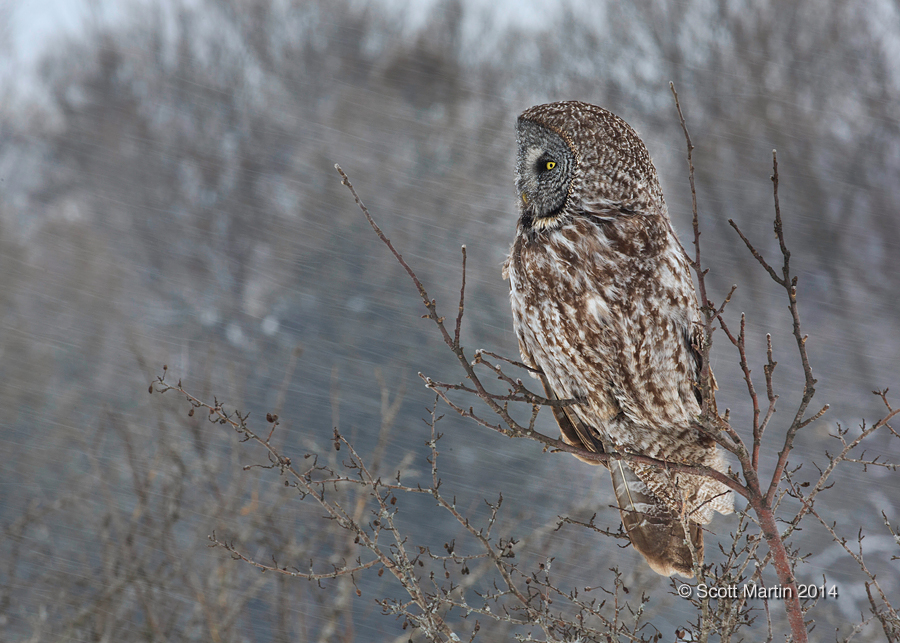
The challenge with slow shutter speeds is causing out of focus results either from camera shake or object movement during the exposure. So even using a lens with image stabilization, mounted on a tripod, I took at least a dozen shots to finally get one with the owl in sharp focus.
The next time you have the opportunity to take your camera out into the snow, don’t be afraid to do it, but always think about how the snow will impact your images and experiment with different shutter speeds until you create the desired effect. Also, when photographing birds, remember that slow shutter speeds are always the last thing you experiment with and don’t forget to set your exposures back to high shutter speeds as soon as you get the shot you want. Nothing is more frustrating than missing an owl launch from its perch while you have your camera dialled in at 1/30 sec! Fortunately I was back at 1/1600 sec for this next capture.
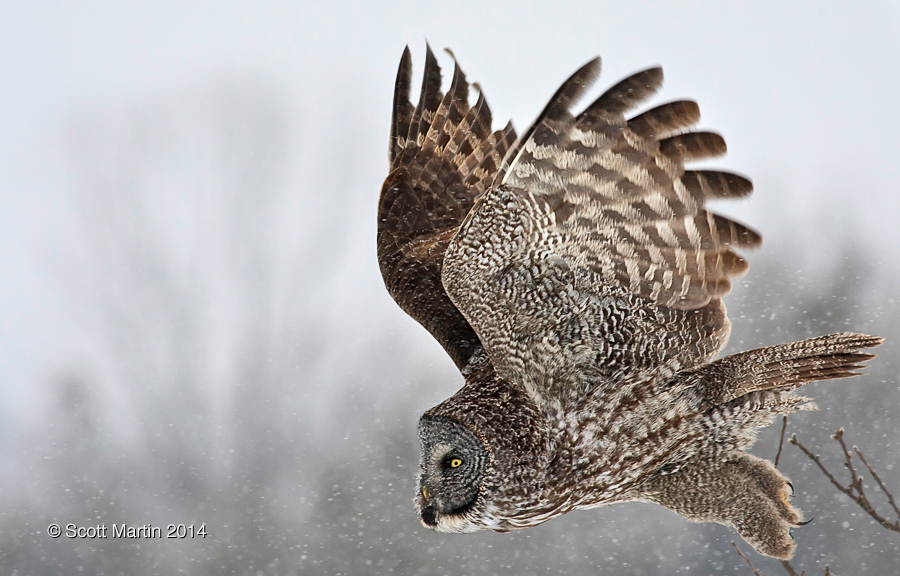
When shooting in less than ideal weather, the light is often quite nondescript producing the white/grey back grounds that typically are not visually appealing. However always try to use the light to your advantage. The over cast lighting reduces the natural contrast between the light & dark areas in the frame which is sometimes referred to as high key lighting (especially when there are no fully black shadows in the image). If you don’t like the high key look you can always add blacks and contrast during post processing which is what I did in these next few images.
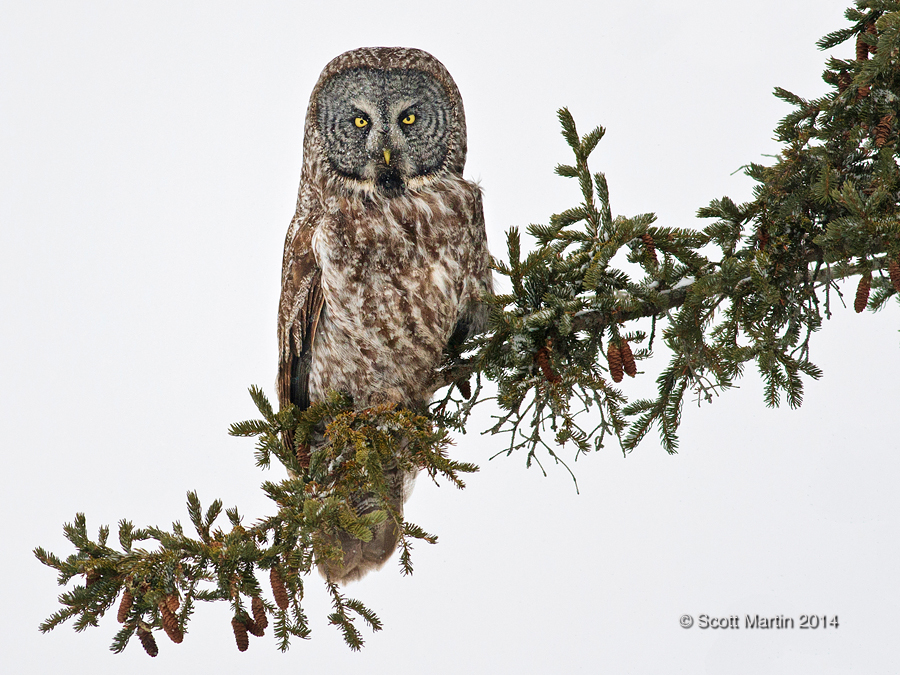
Images like these with an all white back ground are perfect to use as title slides in any presentations you may be doing.
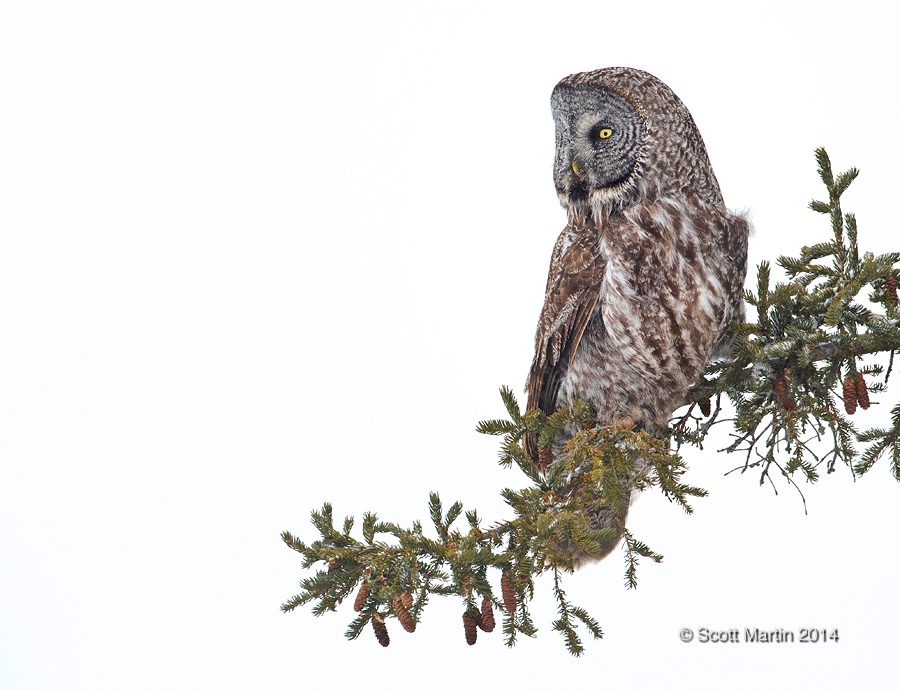
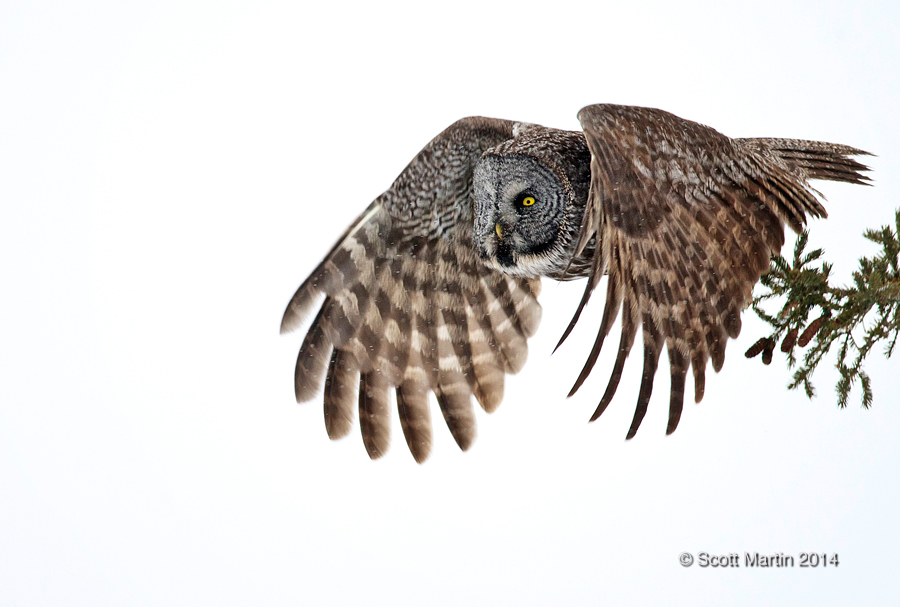

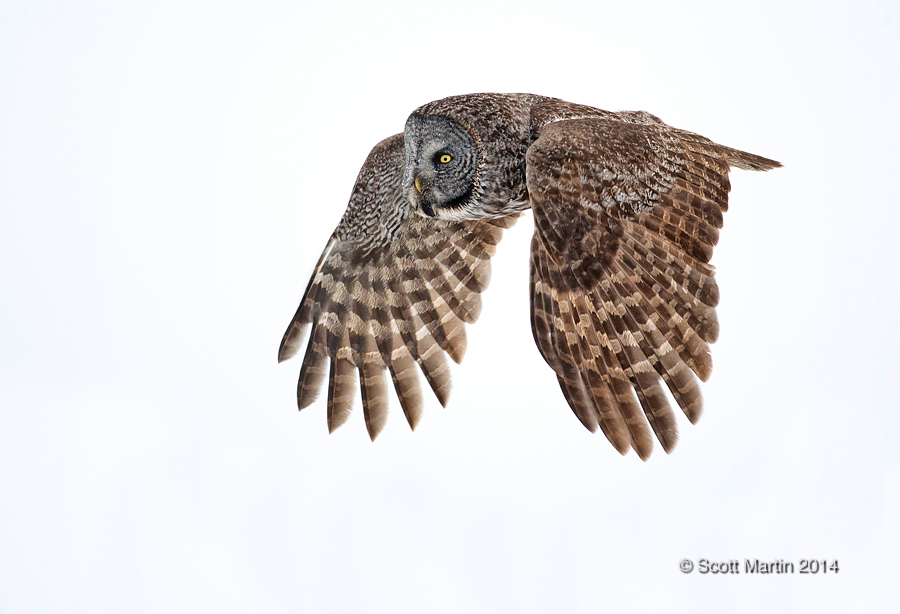
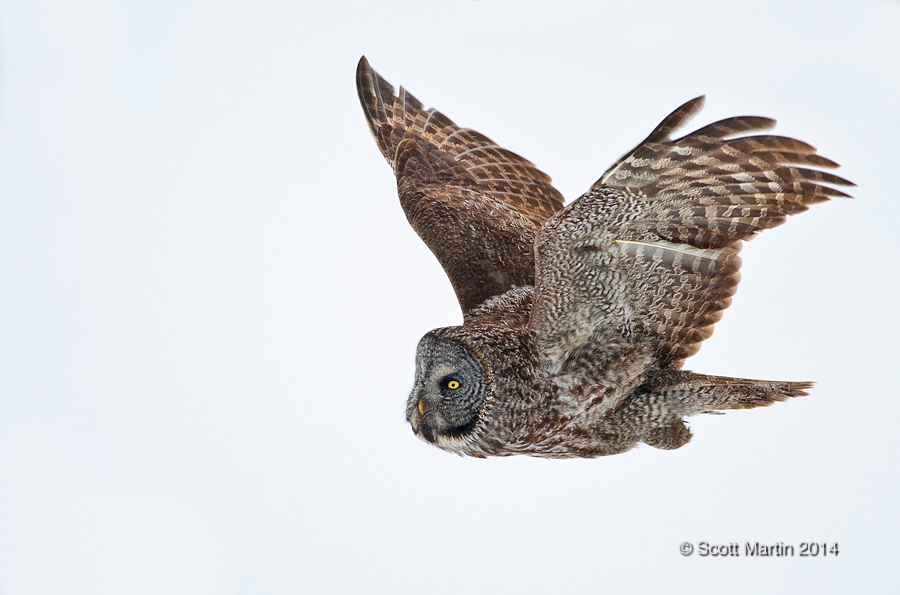
Bird photographers are usually upset when they cut off parts of the bird, but sometimes these accidents work out well. This next image is almost completely un-cropped in post processing (about 15% of the right side of the image was cropped). It just so happened that the owl landed on a perch very close to me and the 400mm lens was ‘too much lens’ so the owl more than filled the frame. The image does capture the concentration, intensity and focus of the owl securing the landing position on the perch it had chosen. Although accidental, the resulting image became a ‘keeper’.
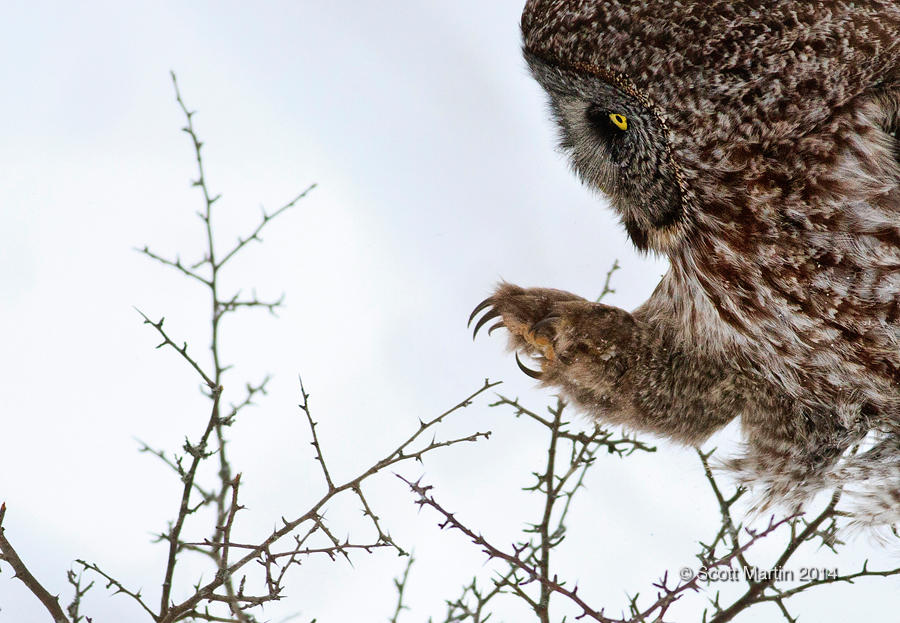
This next image is a crop of a missed launch image taken as the owl took off from its perch and I cut off the head of the bird. The intent then became to crop the image to isolate the legs and tail and convey the great power required for the owl to propel itself into the air. I don’t believe this image works as well as the previous one to convey the message, but the point is, don’t always delete your ‘mistakes’ before looking at them closely to see if perhaps there is a picture within the picture that can be used for an intent other than originally planned. They don’t always work (as shown in these two images) but when they do, it is a pleasant surprise.
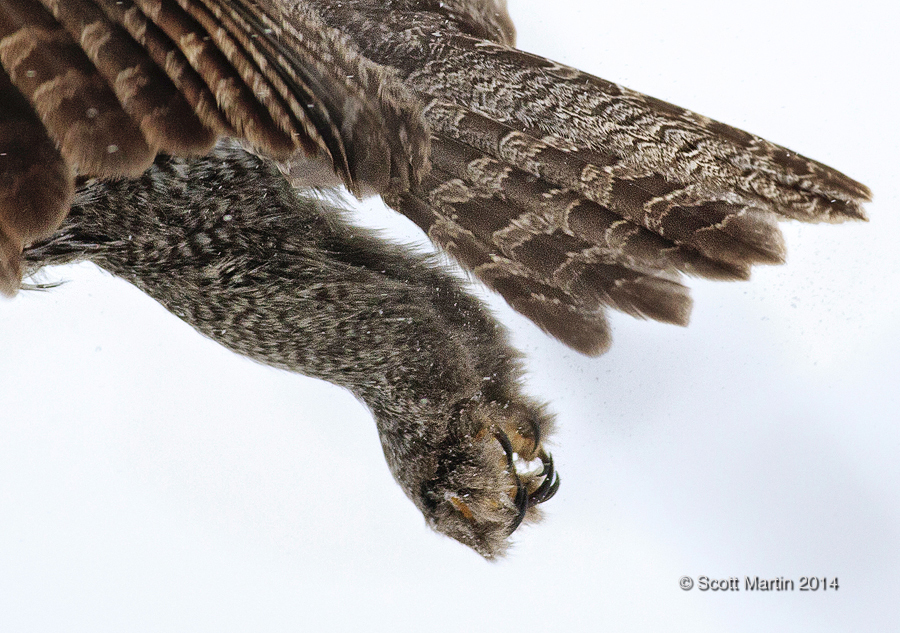
The last sequence of images in today’s post illustrates one of the typical hunting methods of the Great Gray Owl.
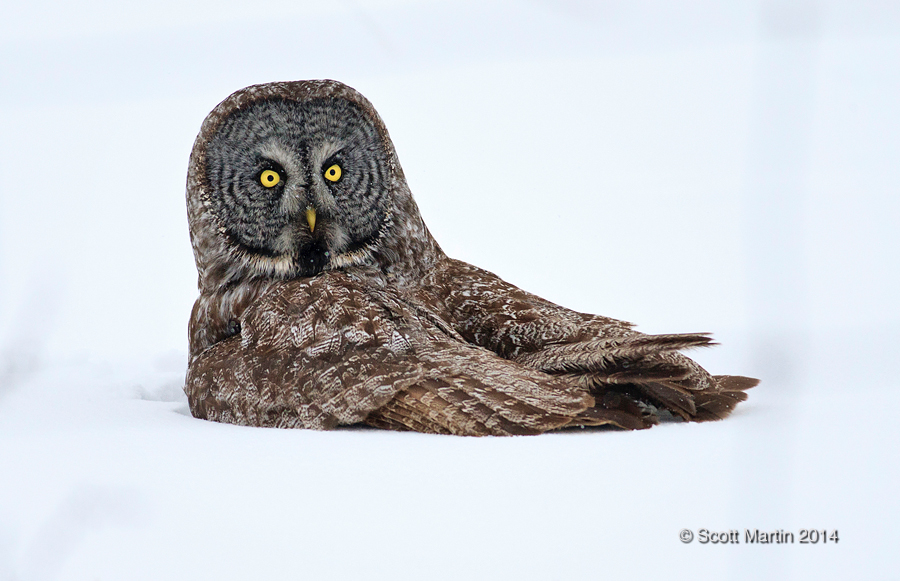
Great Gray Owls use sound and hearing as the primary sense required to effectively hunt for food and although they do have incredible visual acuity, they are most active feeding before dawn and after dusk when hearing is more important than sight. Their large facial disks act as parabolic reflectors amplifying and concentrating sounds on their asymmetrically located ears allowing them to accurately locate prey, up to two feet below the surface of the snow. This is truly amazing when you stop to think about it.
Listening intently to locate the prey.
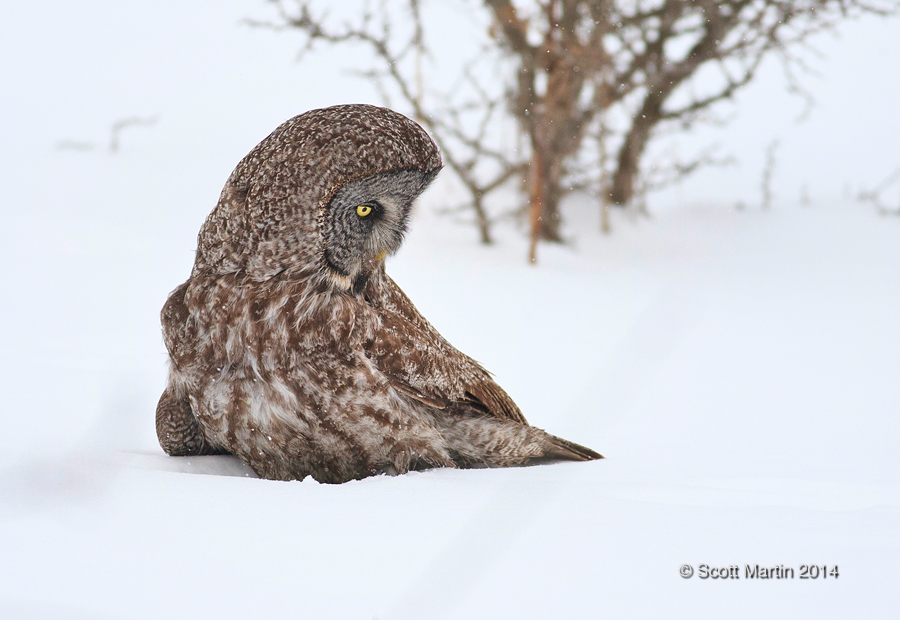
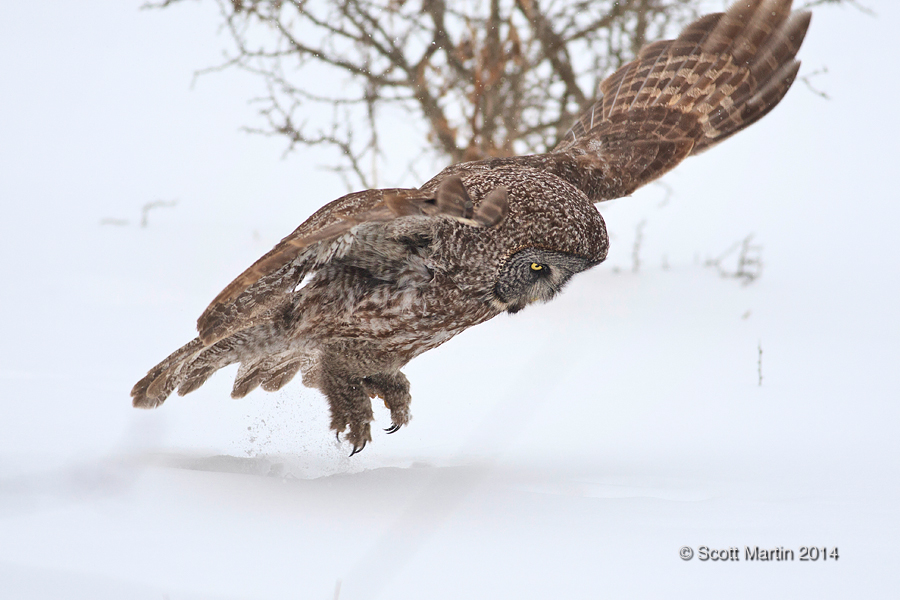
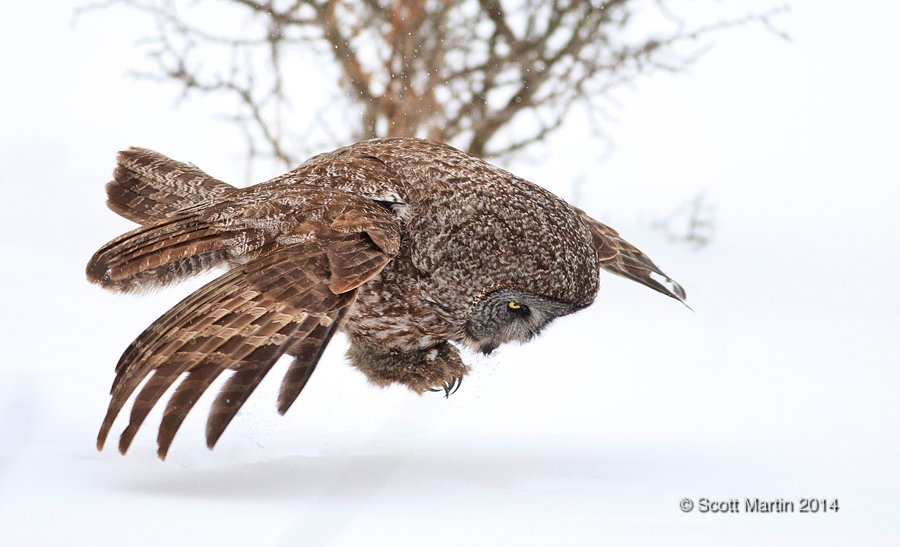
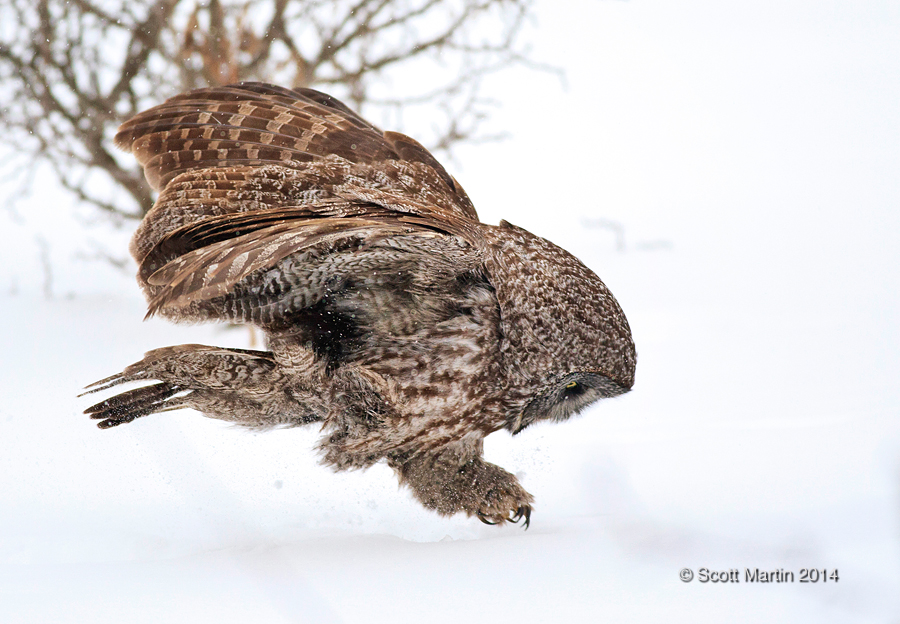
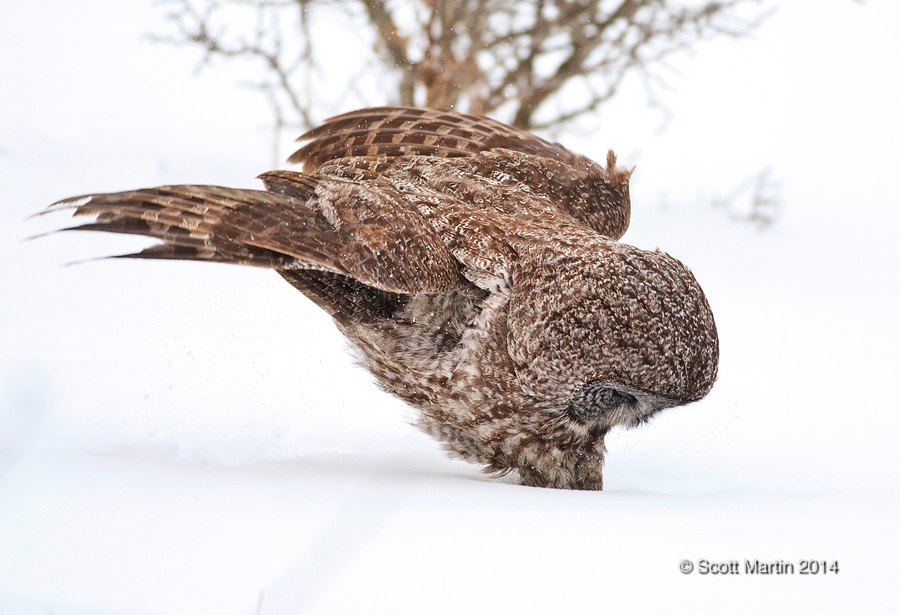
Hopeful success.
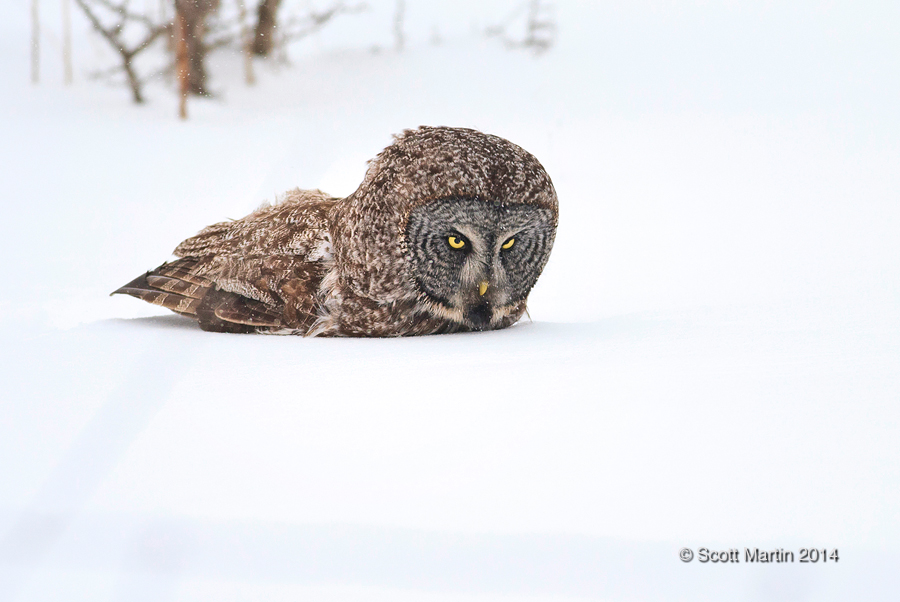
The images posted in today’s blog were taken with two different gear combinations, a Canon 5D MkIII with a 500mm lens and a Canon 1D MkIII with a 400mm lens.
It is always a pleasure to spend time out taking pictures, however it’s even more special when you get to do so with great friends and on the day we took these pictures Deb & I were joined by Arni & Dianne who made the trek south from Orillia to see the Great Gray Owl. You can see Arni’s shots of the Great Gray Owl posted on his blog.
I trust you enjoyed seeing these Great Gray Owl images and as always, your questions, comments and critiques are much appreciated.
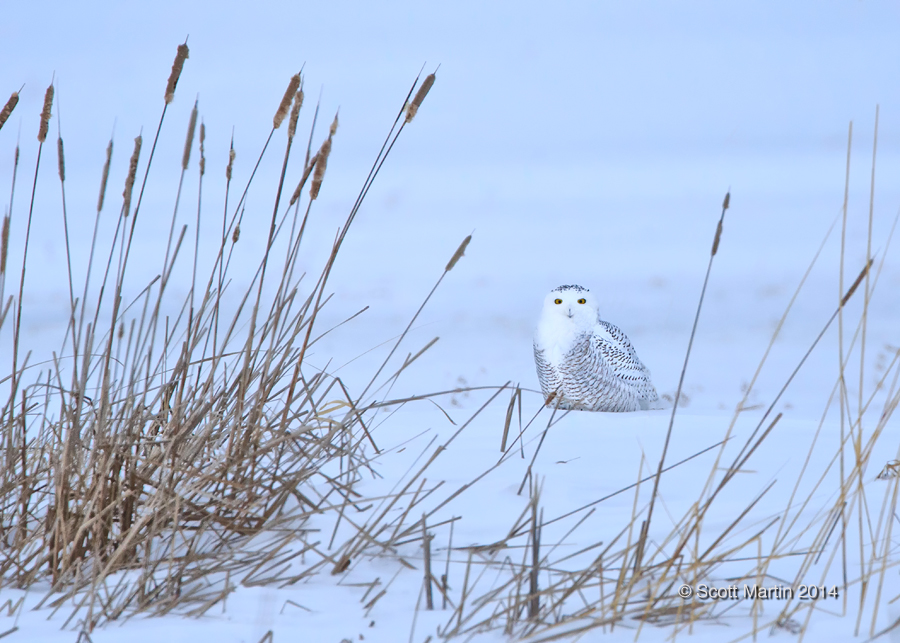
by Scott Martin Photography | Mar 3, 2014 | Birds, Blog, Educational, Raptors, Shore Birds & Waterfowl, Wildlife
This winter has been unusually long and cold with our province blanketed in snow to depths that I can’t recall since growing up in the Ottawa Valley. Fortunately it has also been a pretty good winter for bird photography, especially regarding Snowy Owls for which this year has been an irruption year. An irruption year occurs infrequently and although there are different theories as to exactly what causes a particular species of bird to head farther south in greater numbers than usual, it most likely revolves around competition for food. In winters when food supplies are scarce or years that bird populations are large, the competition for food forces the disadvantaged (the young, very old or infirm) south in search of more easily obtained food. This is why Snowy Owls found significantly south of their normal range are usually young first year birds. After wintering farther south than normal and eating well, the owls head back to the Arctic in February or March for the next nesting season. The Snowy Owl irruption experienced this year has been the largest in 40-50 years and a Snowy Owl actually made it to Jacksonville Florida, which is incredible for a non migratory Arctic bird! When Snowy Owls are displaced southward they seek areas to stay that remind them of the tundra they are accustomed to, so you often find them in open areas such as farmers fields.

Their predilection for farmer’s fields results in the classic images we see of Snowy Owls perched on fence posts. 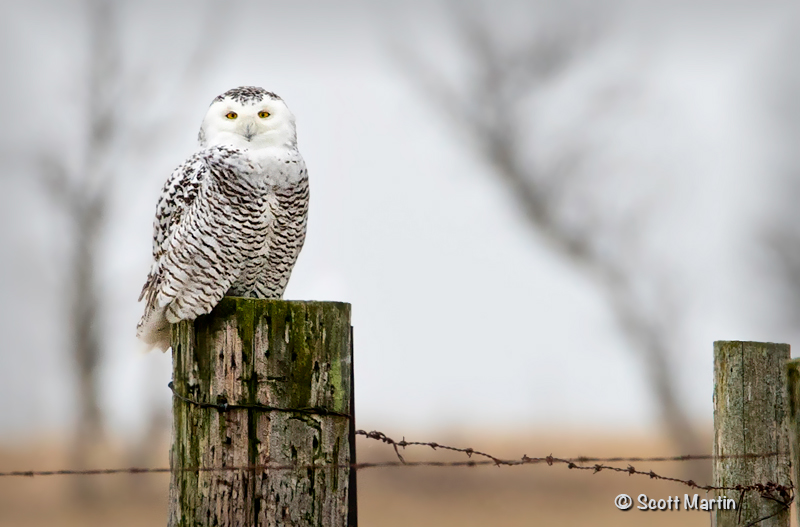
Although not the biggest or heaviest owl, the Snowy is still an impressive bird about 2.5′ high with a wingspan of five feet and weighing up to six pounds. Only in flight can you get an appreciation for their wingspan.
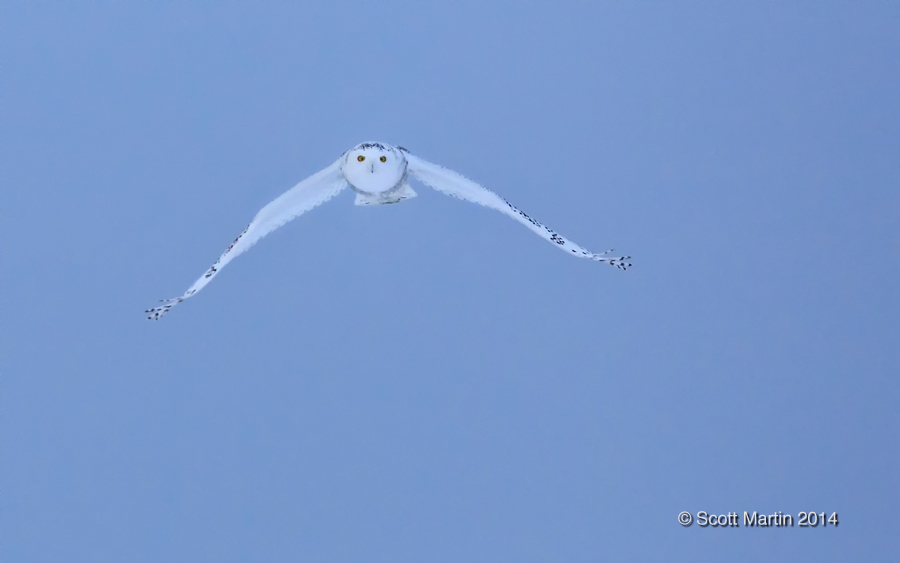
Deb and I were photographing a Snowy Owl last month when a snow squall moved through the area and presented us with the opportunity to get a unique image that I hope illustrates the type of environment the Snowy Owl is used to in the high Arctic.

The winter months in Ontario are also a great time to see a number of northern diving ducks which winter on the Great Lakes. In fact the introduction of Zebra Mussels in 1988 to Lake St. Claire and Lake Erie from a European freighter and their subsequent infestation of the Great Lakes (particularly Erie & Ontario) has provided a dubious but plentiful food source for the ducks. Consequently in recent years we have seen more varieties of ducks as they change their historic migration patterns to include the Great Lakes and the Zebra Mussel buffet they provide.
On a recent tour of Southern Ontario looking for winter owls and ducks with my good friend Arni, we were able see a number of different duck species as well as four different owls species. Arni is a birder and photographer second to none and you will enjoy following this link to his website. These next images of ducks were taken on our tour and although it was a dreary day the poor light did not stop Arni and me from enjoying both the birding and the photography as well.
First up is the Red Breasted Merganser, the rarest of the three Mergansers in North America, and a new bird for me to photograph. If you want to see the other two Merganser species (Common Merganser and Hooded Merganser), they can be found in the Waterfowl Gallery.
Baby it cold outside!
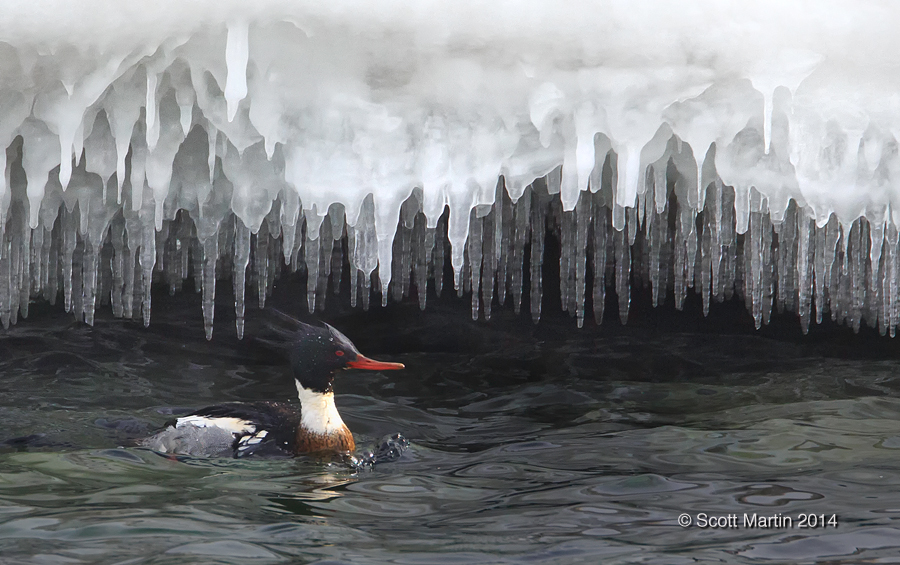
.
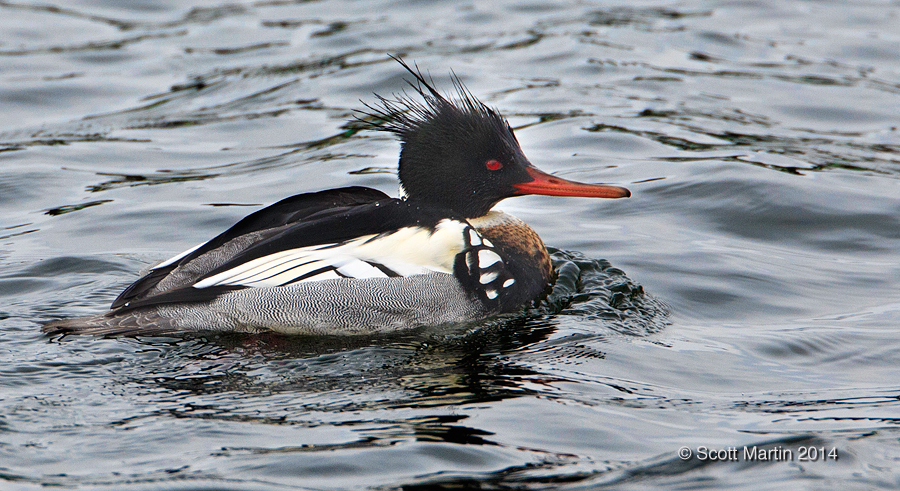
This next image is of Red-headed ducks, another relatively new and unusual visitor to the Great Lakes to feast on the Zebra Mussel. The Red-headed duck is an interesting species as it never builds its own nest, choosing instead to lay its eggs in the nests of other duck species and even in the nests of American Bitterns and Northern Harriers. Apparently they aren’t into parenting!
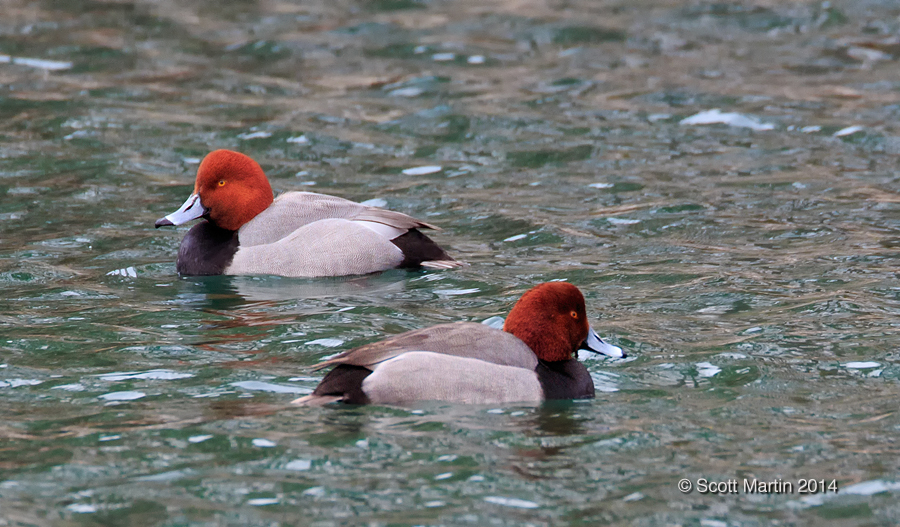
The White-winged Scoter is another Arctic breeding duck that is found through North America, Europe and Asia. It heads south in the winter months and their numbers have been increasing on the Great Lakes over the past few years. They are a large dark brown to black bird with distinctive white markings around the eyes and speculum. The next two pictures are of the White-winged Scoter, the male first followed by the female and both with a clump of Zebra Mussels.
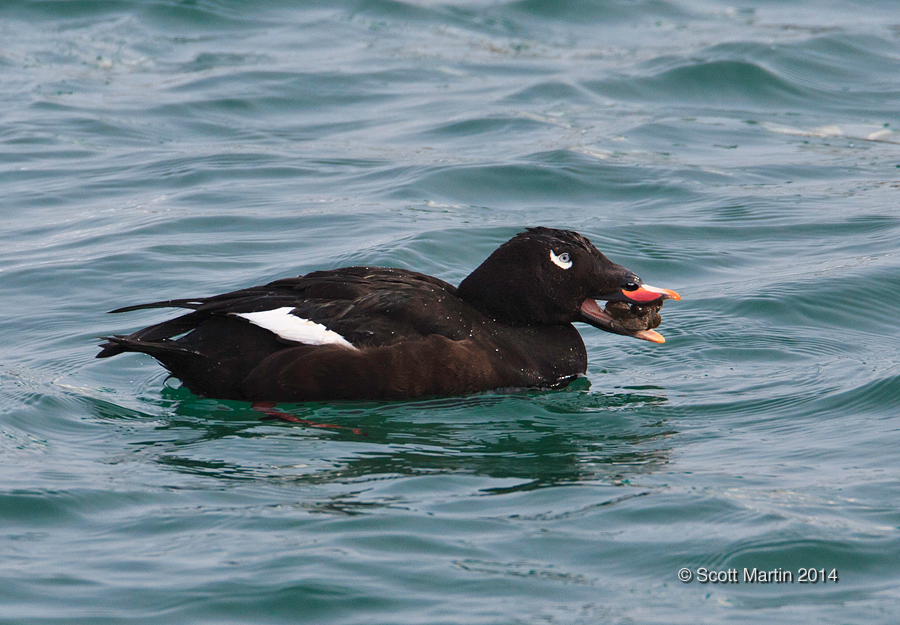
.
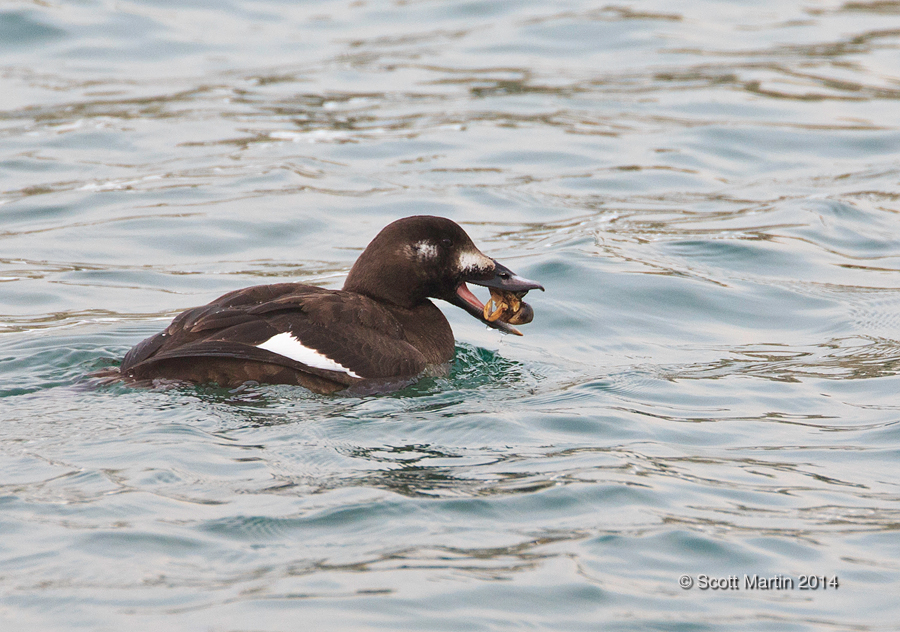
Since the inadvertent introduction of Zebra Mussels to the Great Lakes, they have overtaken Lake St. Claire, Erie and Ontario, largely due to their prolific reproduction with relatively few predators eating into their numbers. A Zebra Mussel has a life span of approximately five years and females begin having young at about six weeks of age, producing one million offspring annually. The crayfish, one of the mussel’s main predators, consumes about 40,000 per year. The Zebra Mussel filters approximately one gallon of water every day, removing nutrients for itself. Unfortunately the toxins in the water, of which there are many, accumulate in the mussel and there in lies the problem for the birds who consume the muscles and with them the toxins and contaminants from the lakes, and in a concentrated form. The health effects on the birds is not yet known, however it is a huge concern to conservationists and researchers who are investigating the effects of the muscles on birds. It is already suspected that avian botulism is transferred via the Zebra Mussel and this kills many birds annually.
Shifting gears back to owls, the first of four owl species Arni and I saw was the Eastern Screech Owl, which was a new species for me to photograph. The Eastern Screech Owl is a strictly nocturnal bird that hunts at night and then finds its roost in a tree cavity where it spends the daylight hours sleeping. They are a small bird about 10″ high with a wingspan of 18-24″. Most Eastern Screech Owls are grey in colour, however about 10% of these owls are a rufus or red morph and it was a pleasure for us to have found this rarer colour of the Eastern Screech Owl.
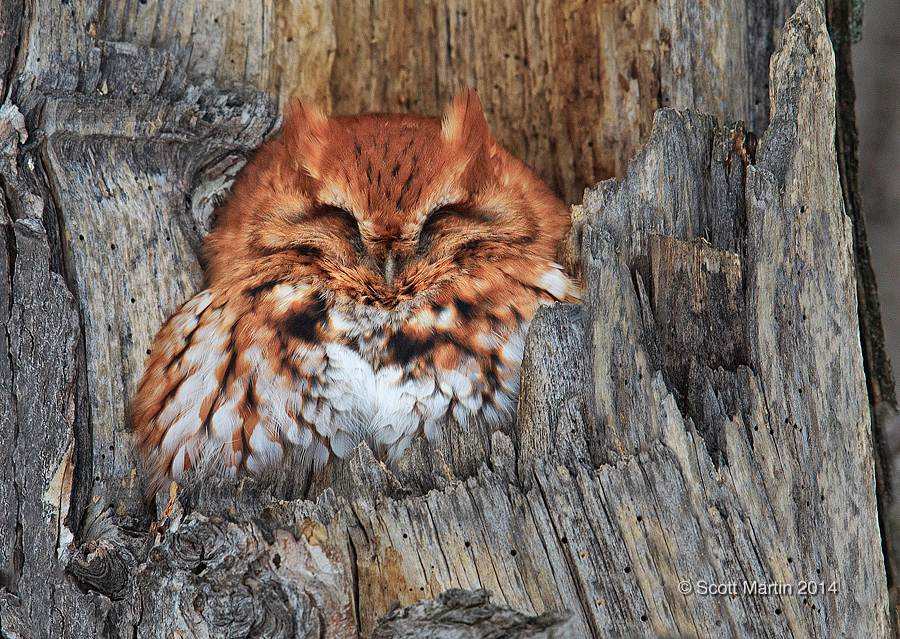
After leaving the Screech Owl we were able to find a Snowy Owl however he was too far away to get any blog worthy images of so we left and arrived at another location where we found a Short-eared Owl hunting over a large area around a quarry. Although we set up out tripods and gear, the Short-eared Owl didn’t fly close by, so as with the Snowy Owl, we struck out getting any shots. The disappointment was short-lived as after arriving at a conservation area on the shores of Lake Ontario we found a large coniferous tree that was home for the day to six Long-eared Owls. It was the largest number of owls I’d ever seen in the same tree.
The Long-eared Owl is a slender owl with long ears, large bright yellow eyes and huge eye discs that give it a characteristic look that is hard to miss.
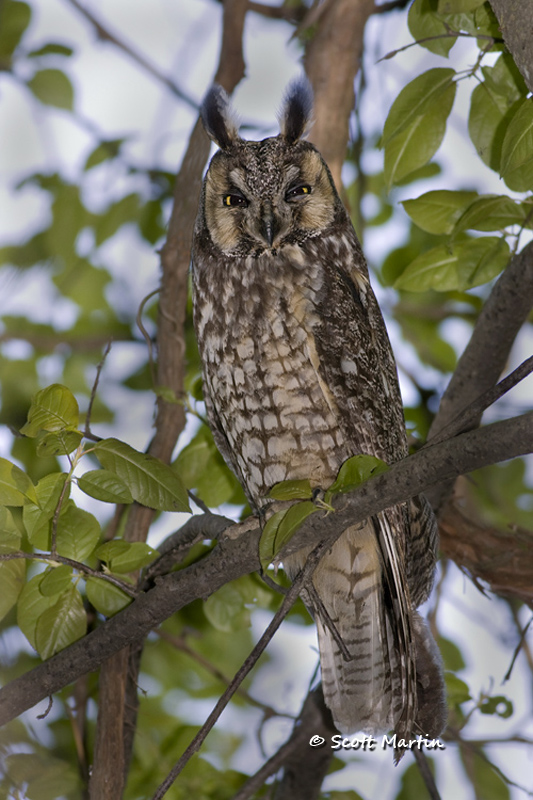
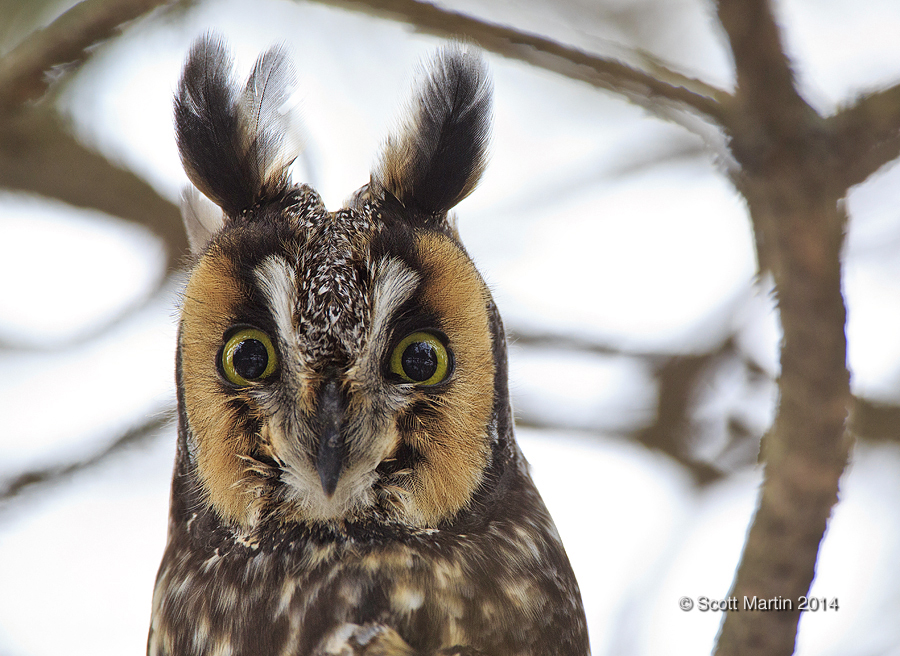
It was also a pleasant surprise to catch one in flight.
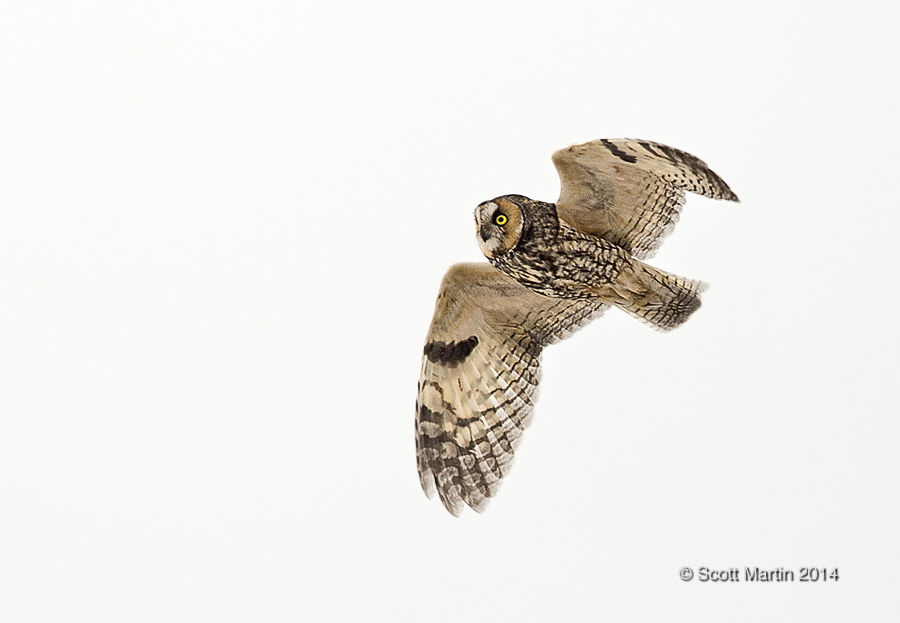
Many photographers put their camera gear away for the winter, but as long as you dress for the occasion and make sure your batteries are fully charged, cold weather photography is a lot of fun and often affords the pleasure of seeing birds that you simply can not see in Ontario at any other time of the year.
We’ve been privileged this winter to also have photographed two other species of owl, the Great Gray Owl which the world’s largest owl and the Short-eared Owl which is arguably the prettiest of the owls. They will form the subject matter for the next two blog posts before retuning to our European tour.
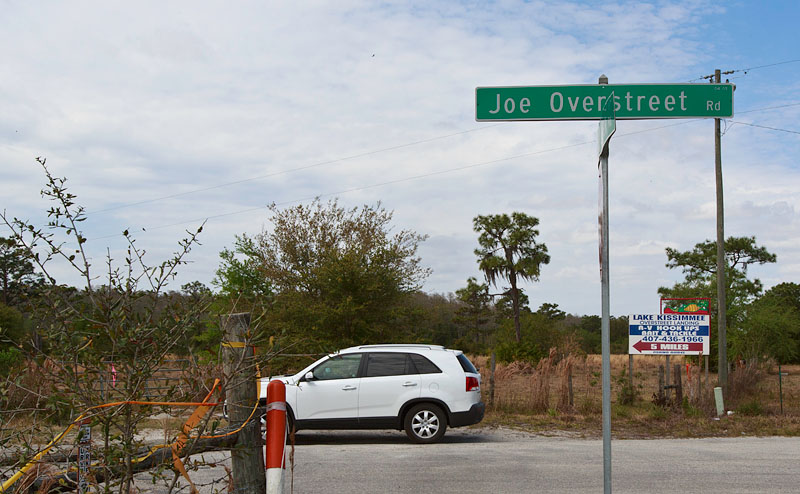
by Scott Martin Photography | Mar 29, 2013 | Birds, Blog, Raptors, Shore Birds & Waterfowl
Birders and bird photographers traveling to Florida need to make it a priority to travel the five miles along Joe Overstreet Road; a gravel road that ends at the shores of Lake Kissimmee. The variety and quantity of birds that are experienced never disappoint. Deb and I have been making the trip for a number of years now, and although we often see Eagles from afar, this year a couple of mature Eagles, flying with a group of Black Headed Vultures, made a pass fairly close overhead. It was quite a surprise as I was at the water’s edge photographing a Wilson’s Snipe which had been actively foraging for quite a while when suddenly it dove for cover and hunched down on its belly, a sure sign that it was troubled by something. When a bird acts like this it is a sure sign to look up, which I did, expecting to see a hawk overhead, however this time it was a Bald Eagle about thirty feet above my head.
A rather inauspicious entrance to a fabulous birding experience.

The Wilson’s Snipe that alerted me to the Eagles (note the meal he has just extracted from the mud).
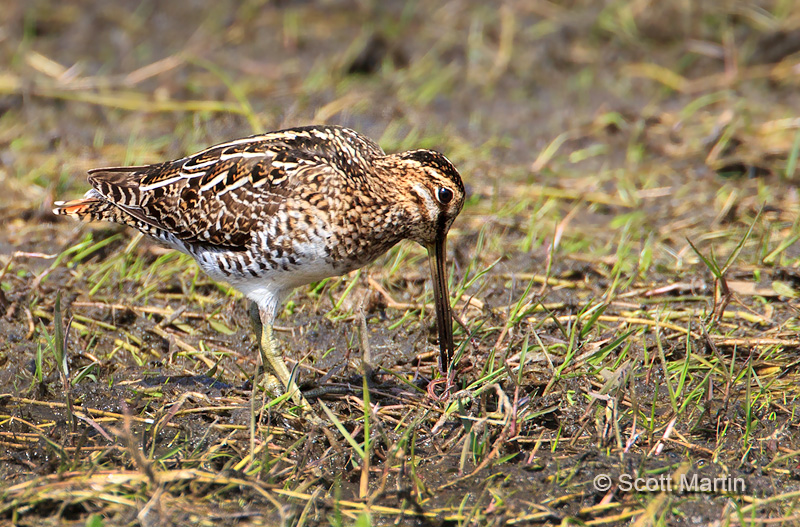
The Bald Eagle is one of the most well known birds in the world, certainly among the Americans who have claimed the Eagle as their National Bird since 1782 and it appears as the central figure in the American Seal. Bald Eagles have a lifespan in the wild of up to forty years and in captivity have lived even longer, although in the late 20th century they were on the brink of extinction due to hunting and the effects of DDT use. In 1963 there were only 417 known pairs and due to concentrated conservation efforts that number increased to 10,000 by 2006. The Bald Eagle is now a common bird in the United States and its name was removed from the list of American Endangered and Threatened Wildlife Species in 2007.
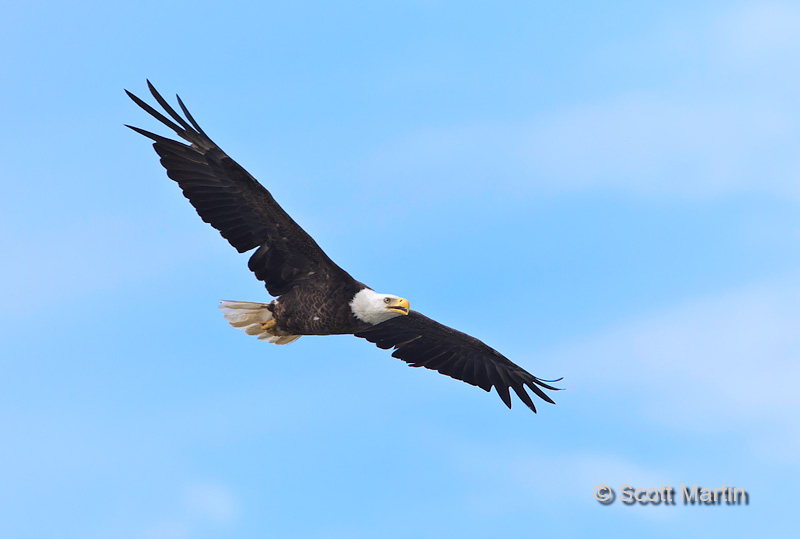
.
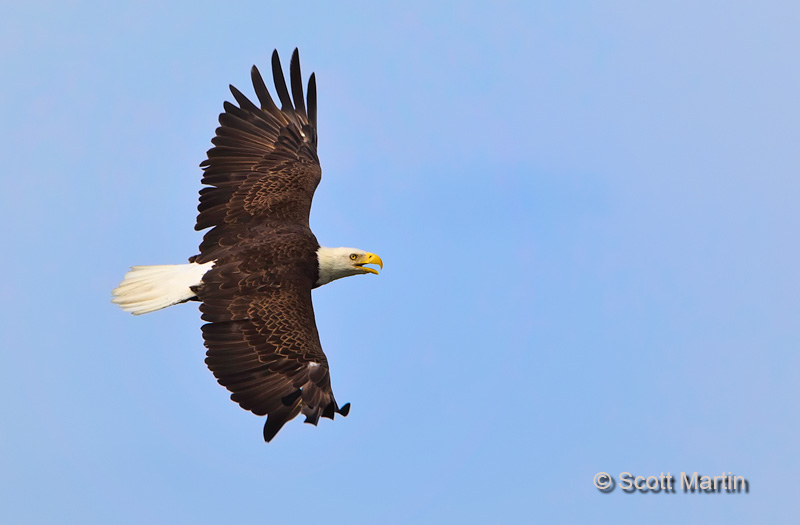
.
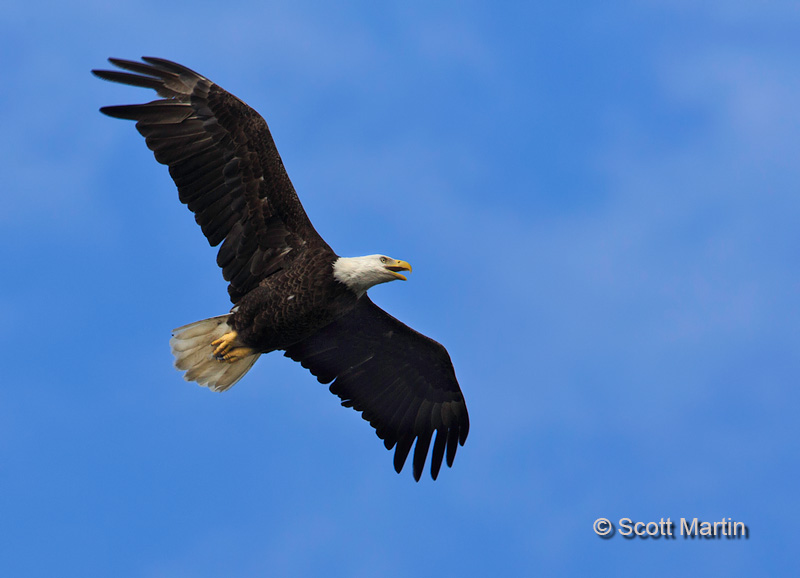
The Eagle images in this post were captured using a Canon 5D MkIII with a 1.4 x TC and 500mm f/4 lens which is not typical gear for inflight bird photography. The camera has a slow frame rate and the use of the teleconverter slows down the auto-focus speed. Both of these issues conspire to reduce the keeper rate so I was pleased to get a few good frames.
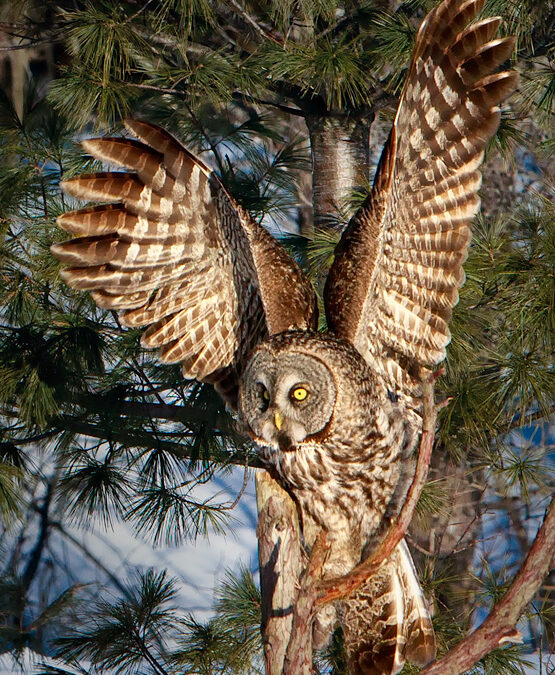
by Scott Martin Photography | Mar 1, 2013 | Birds, Blog, Educational, Raptors, Wildlife
After reviewing the Great Gray Owl shots Deb & I were able to capture in Ottawa a couple of weeks ago, I found a few more that were perhaps nice enough to post.
Although the Great Gray Owl is exceeded in weight by a number of other owls, its large head and long tail help it to be the largest and tallest Owl known in the world. Female adults are almost three feet in length with a wing span of five feet. The average female weighs three pounds although Great Grays have been found as heavy as four pounds.
With their wings outstretched you get a glimpse of just how large these owls are.
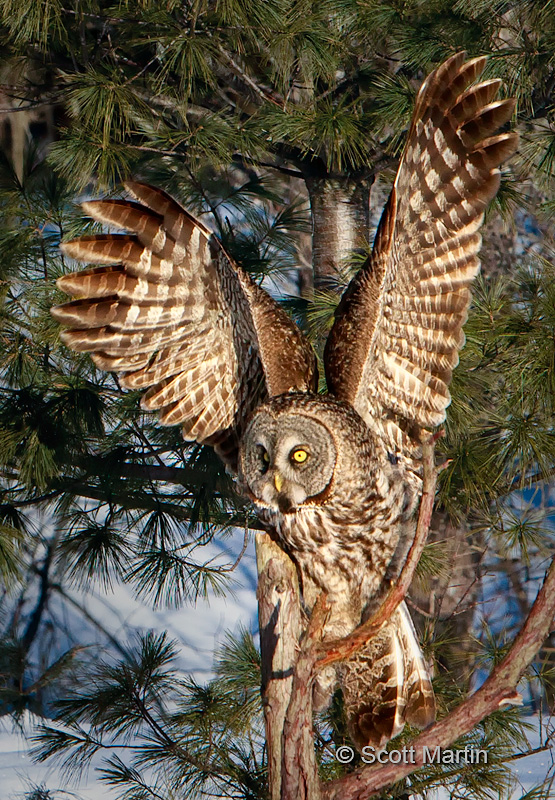
In order to become a better photographer, one has to become their own best, or worst, critic as well as being open to critique from others. It’s the only way we can learn to improve our skills, not only in terms of camera settings and technique but how to think about what a shot is going to look like even before you take it. Although taking pictures of wild birds and animals is difficult and quite spontaneous, you can always make sure you position yourself so the lighting is optimized and many of the elements in the frame (i.e., perch and back ground) are such that they enhance, as oppose to detract from, the resulting image. So lets critique the above image (feel free to leave a comment if you wish); for me technically the face is too soft (a nice way of saying out of focus) and compositionally the perch obstructs and casts a shadow on the owl and the back ground is too close to the bird causing the birds to be ‘lost’ in the back ground. Otherwise, I like the wing position and it’s always a treat to be so close to a Great Gray Owl.
Regarding technique, the soft face was simply because I missed focusing on the eye. The depth of field for this image was about 2m, unfortunately that 2m started just behind the owls face! In order to minimize the compositional challenges in this shot, I reduced the saturation of the back ground about thirty percent using Viveza 2, a NIK Software plug-in for Photoshop as well as using Color Efex Pro 4 to adjust the contrast and colour of the owl. Finally a vignette was added to darken the back ground (using a solid color layer in Photoshop). These were done to try to get some separation between the bird and its background. Another option would have been to blur the back ground, however I chose not to do so as it would have produced an un-natural ‘Photoshopped’ look. Sounds ironic, but virtually all digital images are processed (often heavily) yet the goal is to have a Photoshopped image that doesn’t look Photoshopped!
This next image is included simply for our discussion on critique and as an example of a common occurrence in wildlife photography……what could have been a ‘keeper’ but is ruined by an uncontrolled factor, in this case the owl flew into a deep shadow.
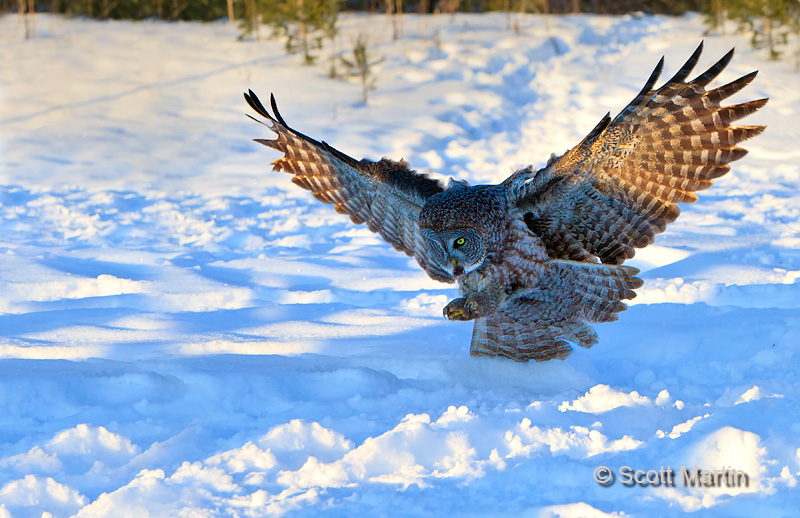
A lot of time was spent in post processing trying to get some detail out of the shadows and add enough contrast, colour and saturation to make the image ‘acceptable’ however it still doesn’t quite work as a great image. In this image the canvas was increased significantly, the back ground cleaned up a dark gradient added to the top half of the frame. We need to learn that its important to take great measures to get the shot right in the camera because no amount of time and skill in post processing can turn an average image into a good one. Photoshop doesn’t rescue anything from the recycle bin, yet we often spend way too much valuable time trying!
This last shot is simply out of the camera with no processing other than cropping and an automated Photoshop action preparing it for posting on the web.
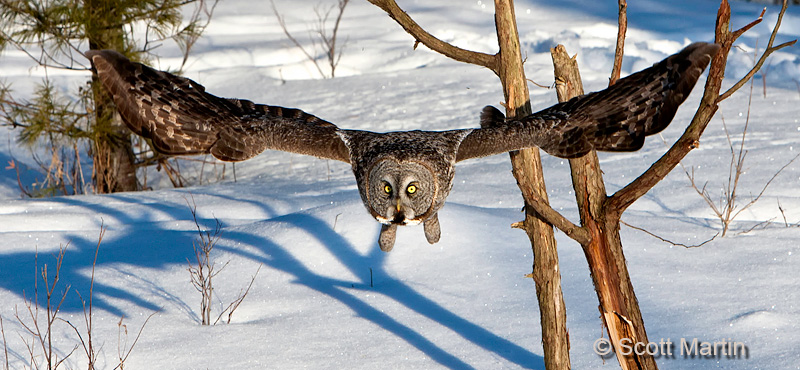
It’s a really busy back ground and won’t end up in a frame anywhere but it does capture the majestic wingspan of a Great Gray Owl and for some reason, purely subjective, I just like it….and that’s the beauty of photography….always strive to get better in every detail, whether it be technical or compositional, but in the end all that really matters is that you simply enjoy the picture!
The three images above were all taken with a Canon 1D Mk III and EF 70-200 f/2.8 L IS lens in -17°C temperatures!
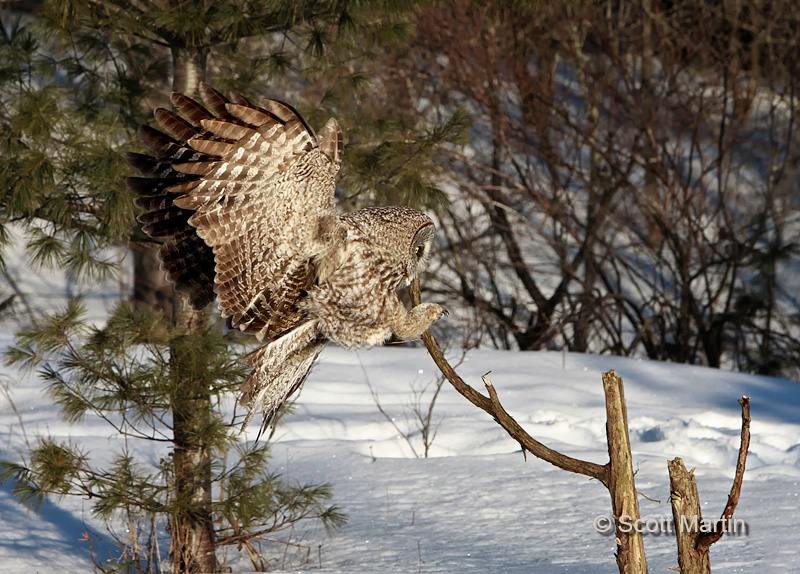
by Scott Martin Photography | Feb 21, 2013 | Birds, Blog, Raptors
Last Friday Deb & I headed to Ottawa for the first half of Family Day Weekend. It was our first time in the nation’s capital in many years and the timing was perfect as it was also the last weekend of Winterlude, Ottawa’s famous winter carnival. We were able to see the Parliament Buildings, take in the ice sculptures in Confederation Park and walk along the Rideau Canal, where I also enjoyed Ottawa’s most famous food, the Beaver Tail.
The primary reason we made the four-hour drive to Ottawa was to photograph Great Gray Owls, of which there are more than usual in Ottawa this winter. Great Gray Owls typically nest and live much farther north (as far north as the Arctic Circle) however during the winter months in years that the food supply in the north is restricted, (or the Great Gray Owl population exceeds what the food supply can deliver), younger Owls that can not effectively compete with adult birds for food are displaced southwards until they arrive at areas where food is plentiful. Once they find a location with an adequate food supply they typically stay until returning to the north in time for nesting season.
Although the owls were located in a well-known location about 15km from the downtown core, getting to the birds involved a twenty-minute hike from the closest place available to park the car. It seemed even longer as we made the trek before sunrise in -17°C temperatures carrying about 30 lbs of camera gear! Watching the sun rise for another day is always a special time and we were reminded of Psalm 118:24 “This is the day the LORD has made; let us rejoice and be glad in it”….which is exactly what we did!
The best light for taking pictures is during what are known as the ‘Golden Hours’ just after sunrise and just before sunset. When the sun is low to the horizon, it is softer and warmer appearing which makes photographs far more appealing than when taken during the mid day hours when the light is harsh. It may seem too early when you are leaving in the dark with your camera gear, but it is always worth the effort!
We were fortunate to see two Great Gray Owls and spend about three hours photographing them. Great Gray Owls are the largest North American Owl and some say largest in the world, measuring over three feet high with wing spans of up to seven feet. I the north their diet consists mostly of Ptarmigan while in the south that changes to voles and mice, of which they can eat up to twenty per day.
I trust you enjoy the photographs of these magnificent raptors and as always, you comments are much appreciated.

.
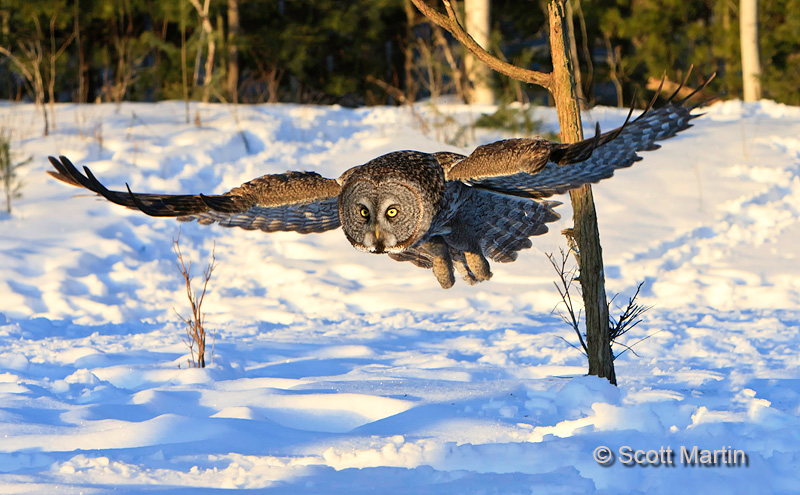
.
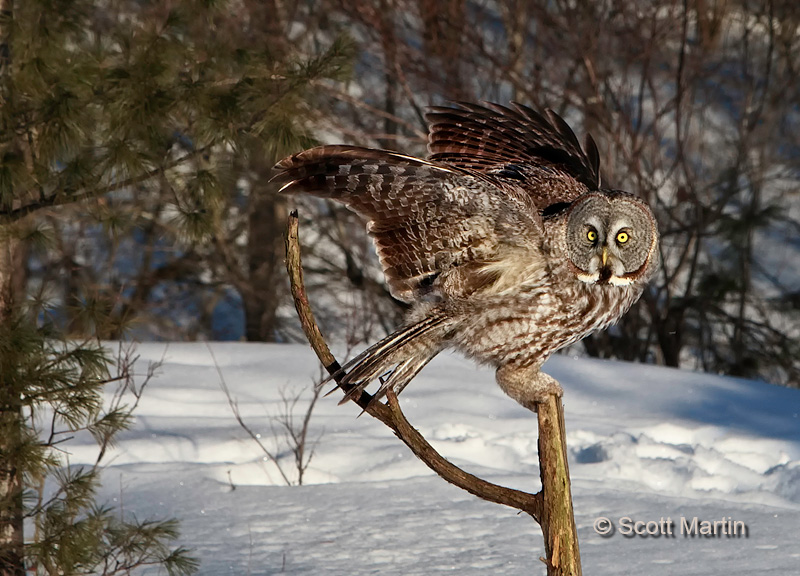
.
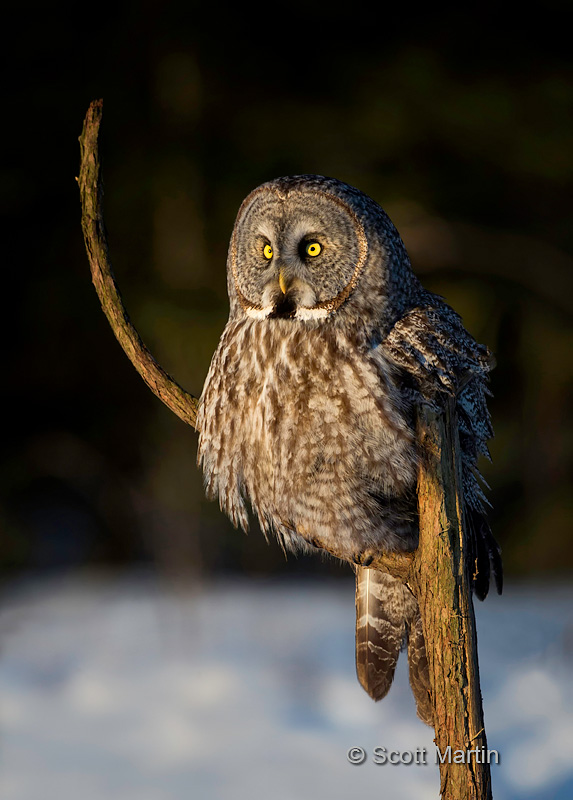
These images were taken with either a 5D Mk III and 500mm f/4 lens or a 1D Mk III and 70-200mm f/2.8 lens.




























































Follow Scott Martin Photography